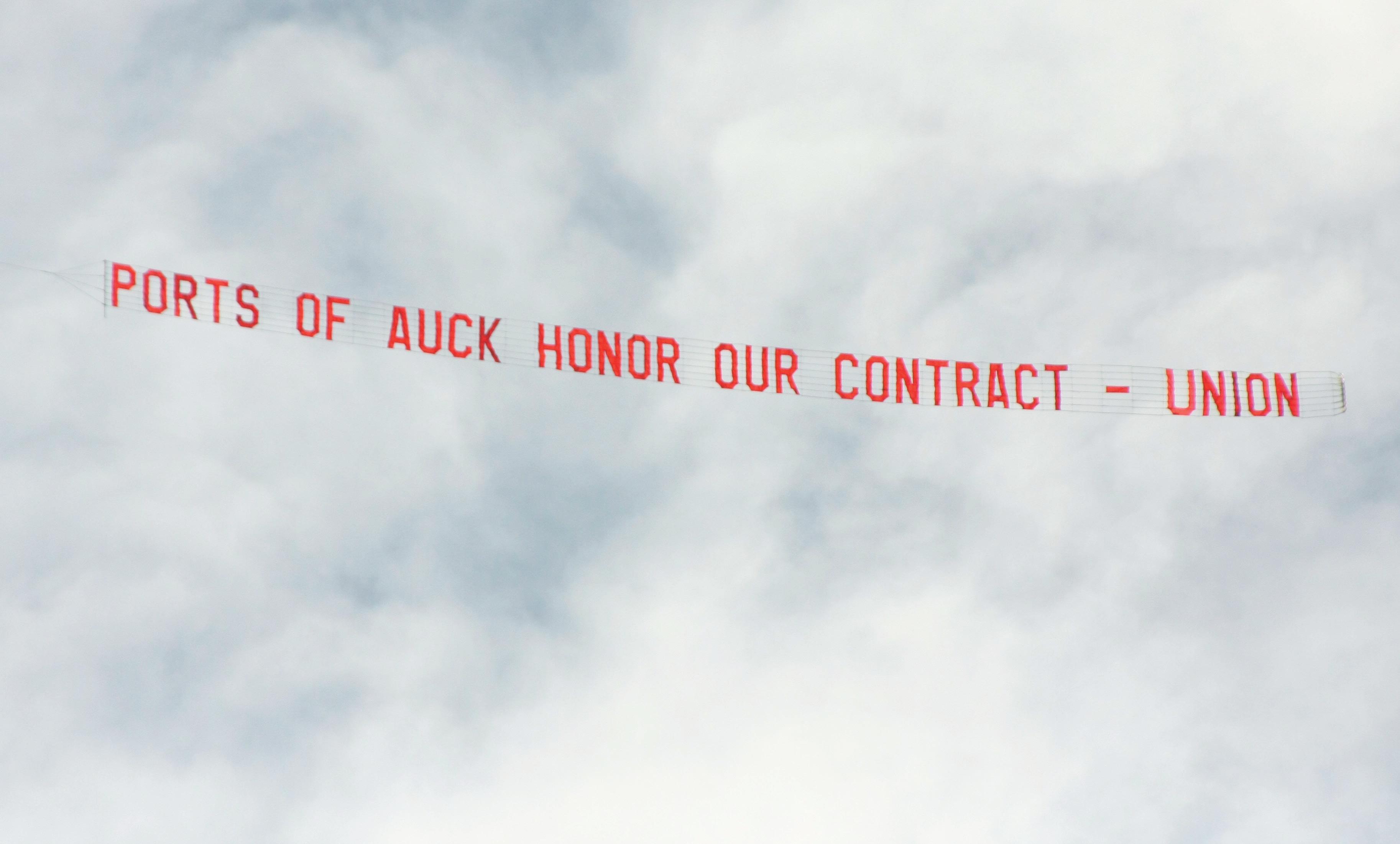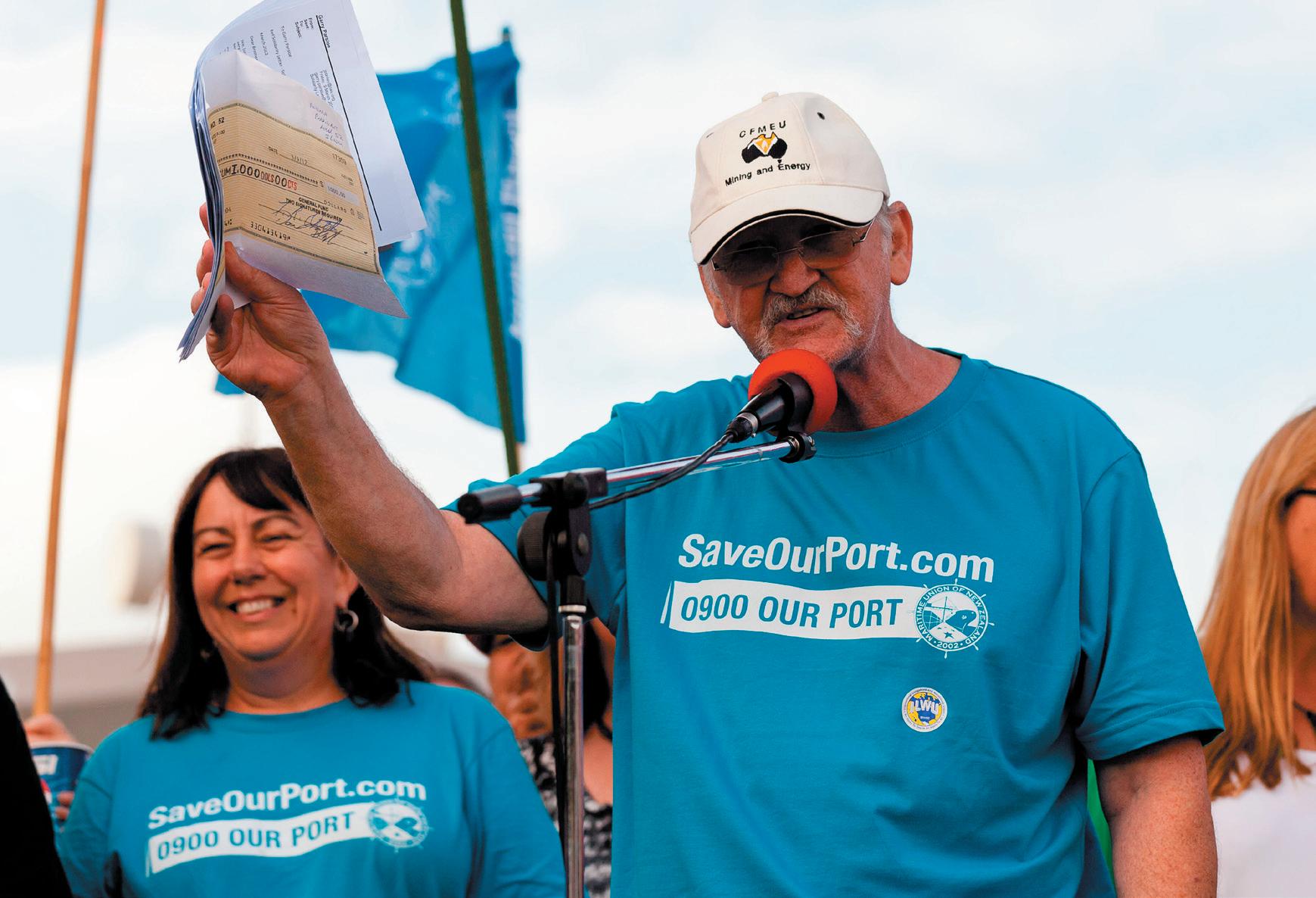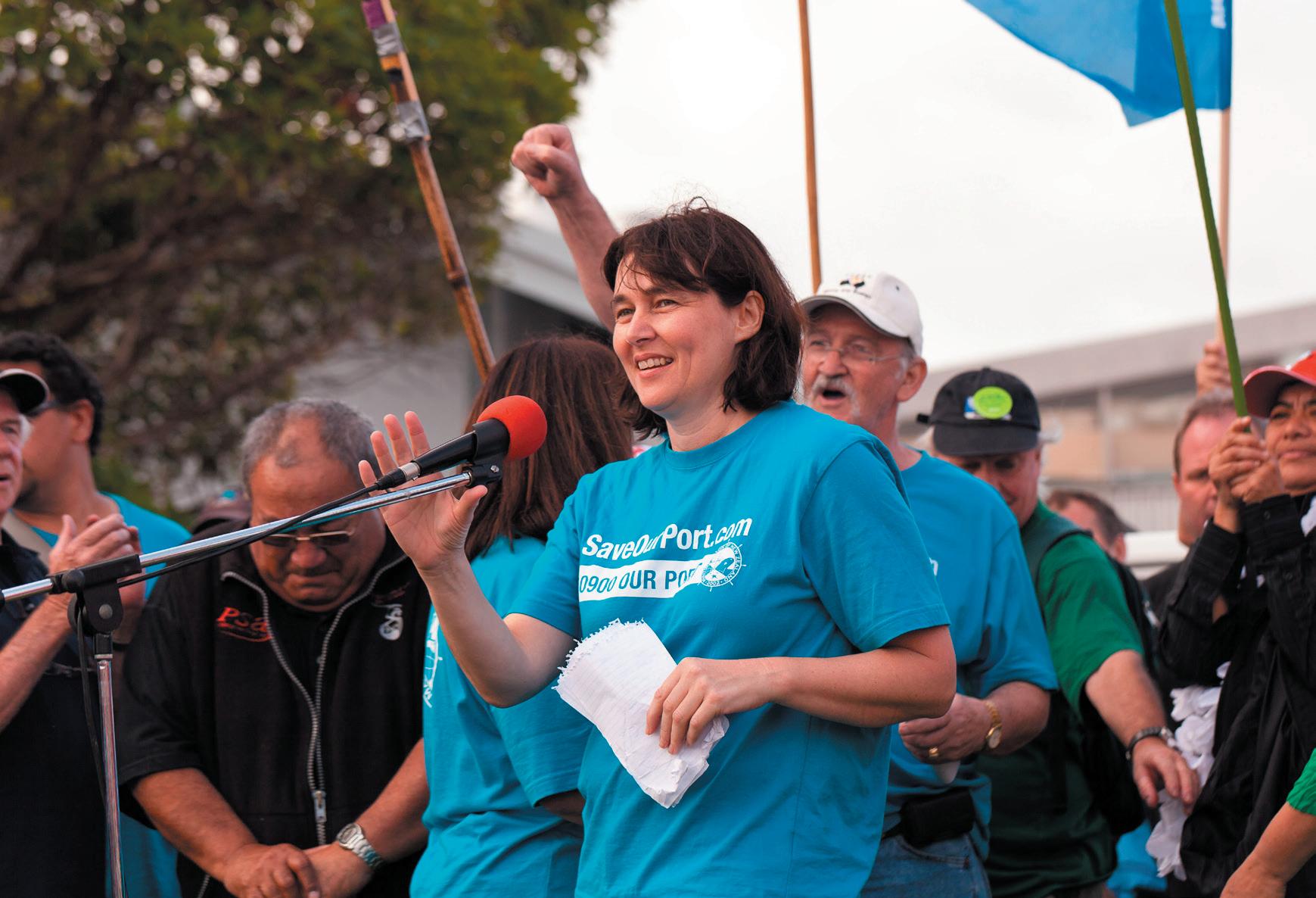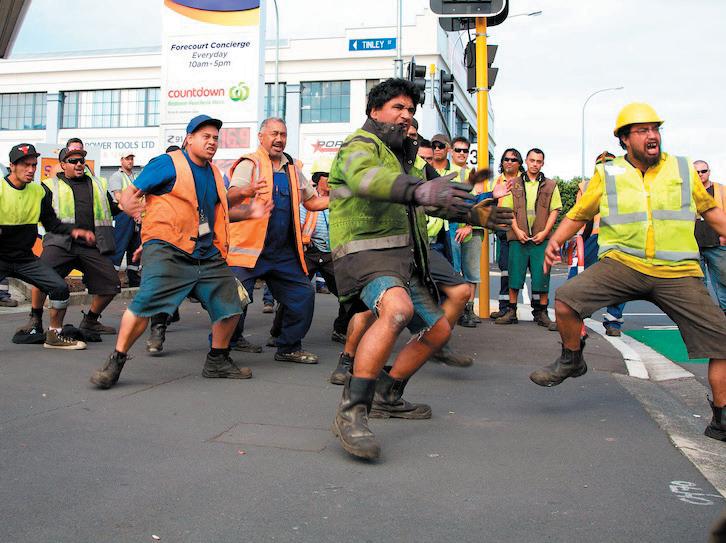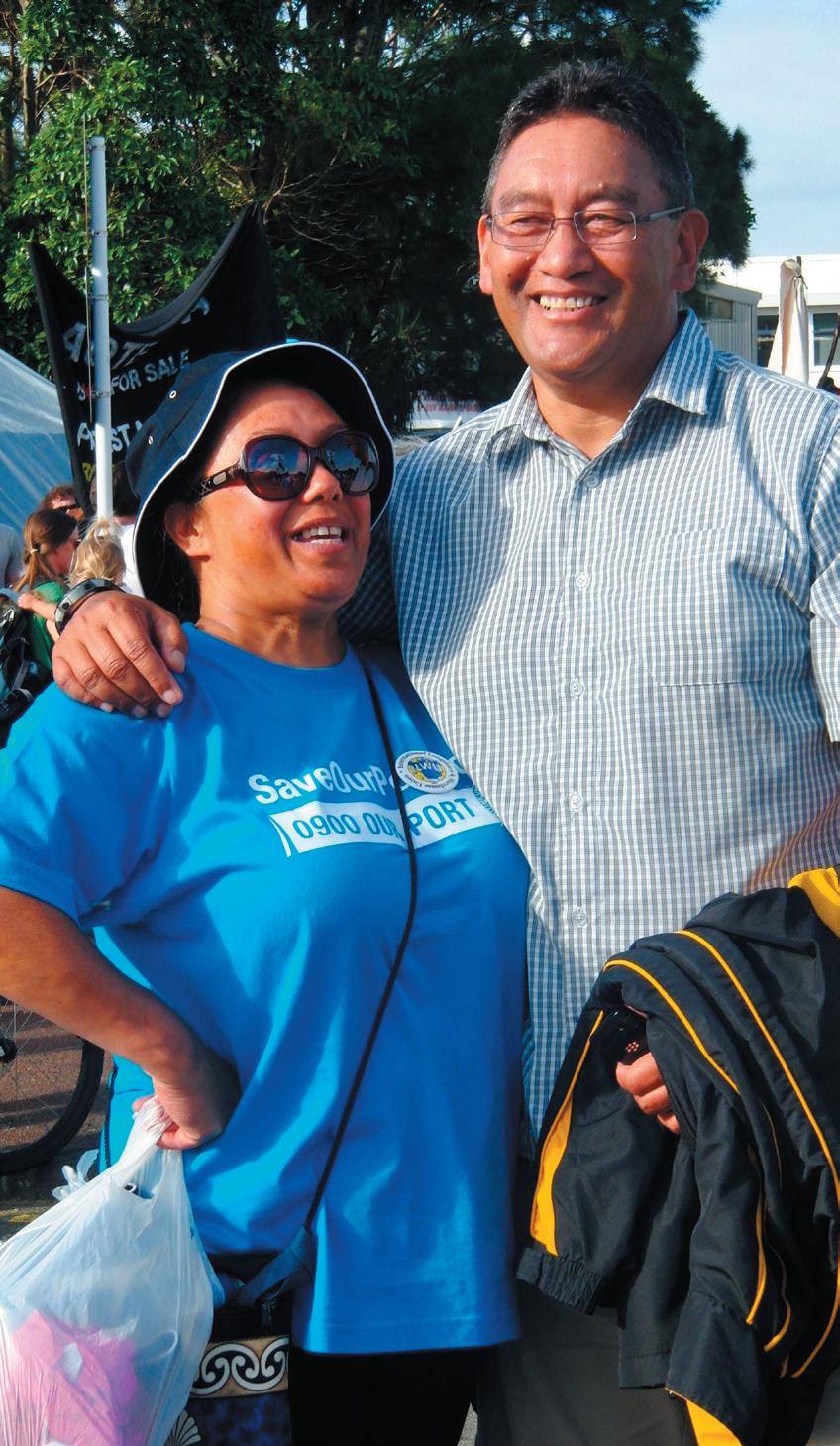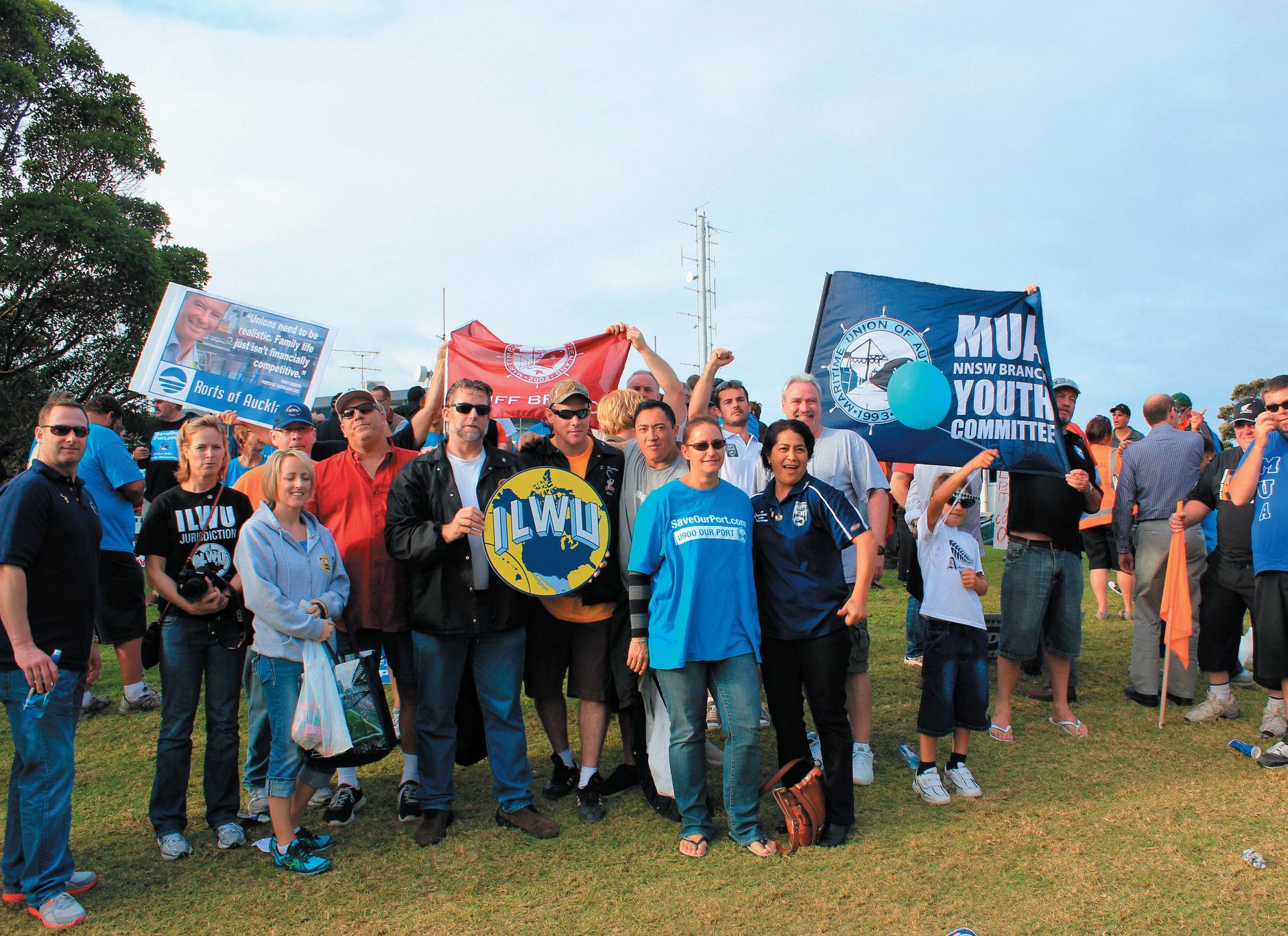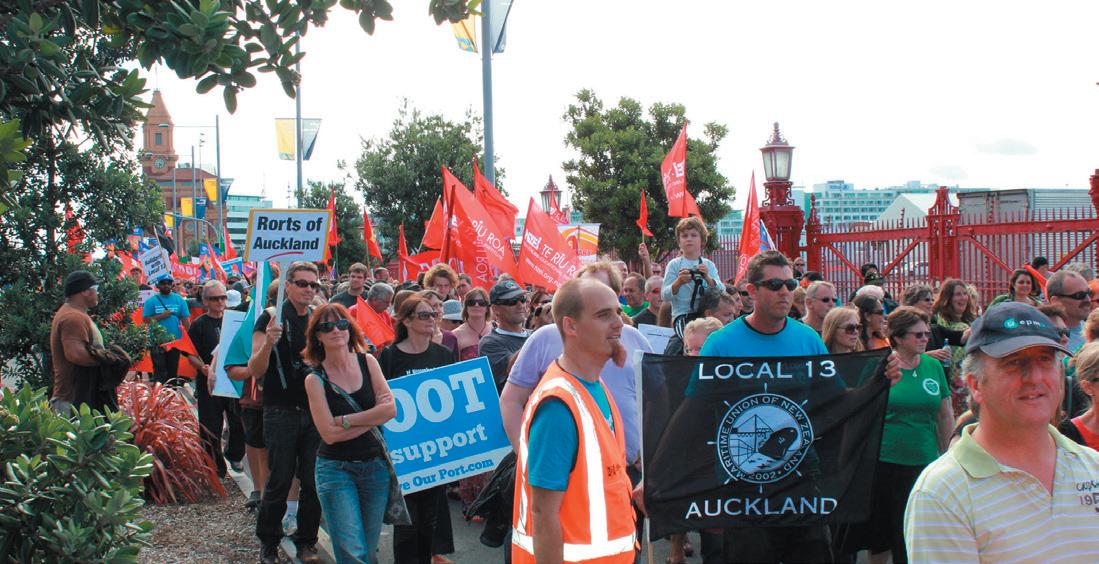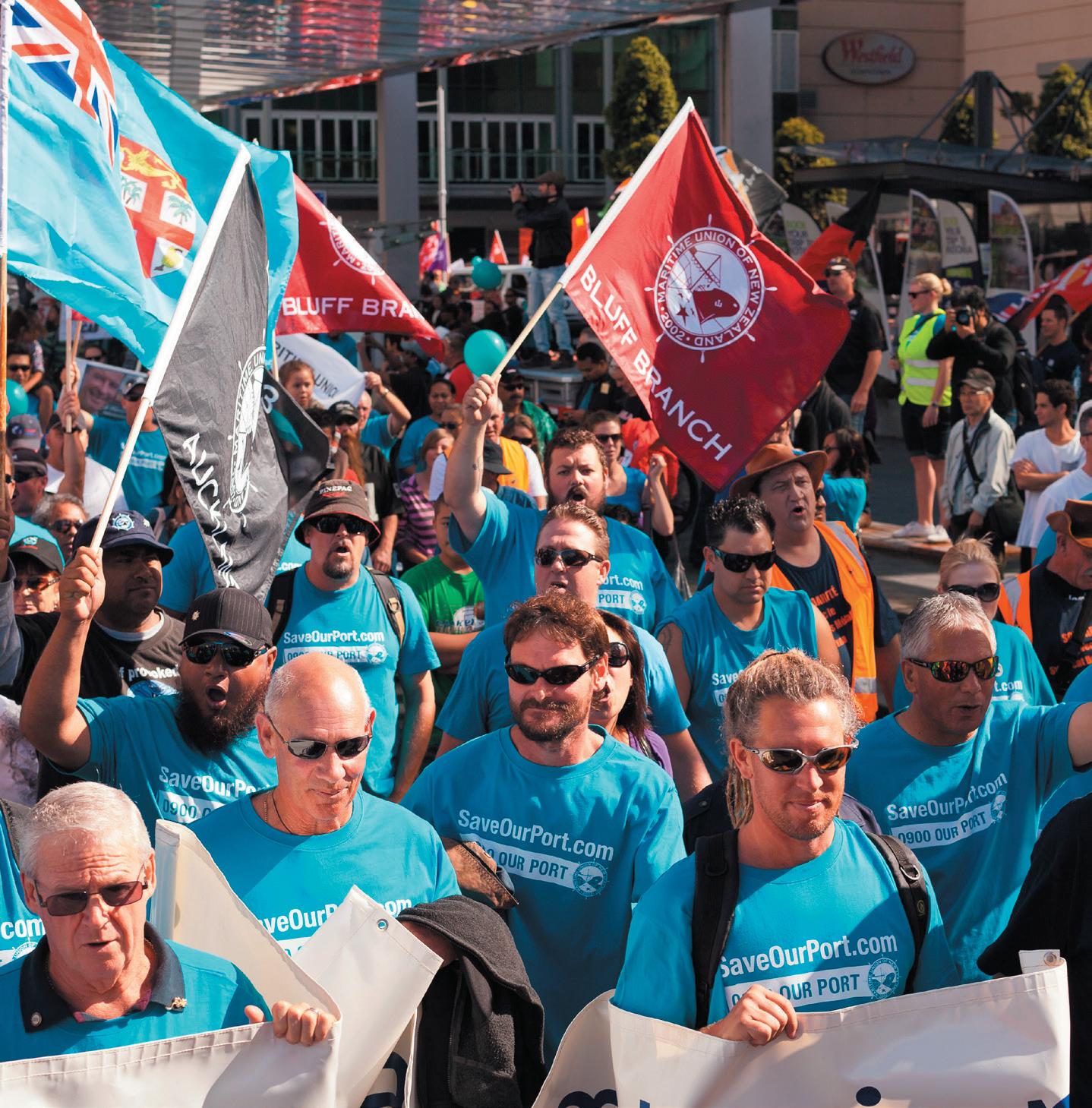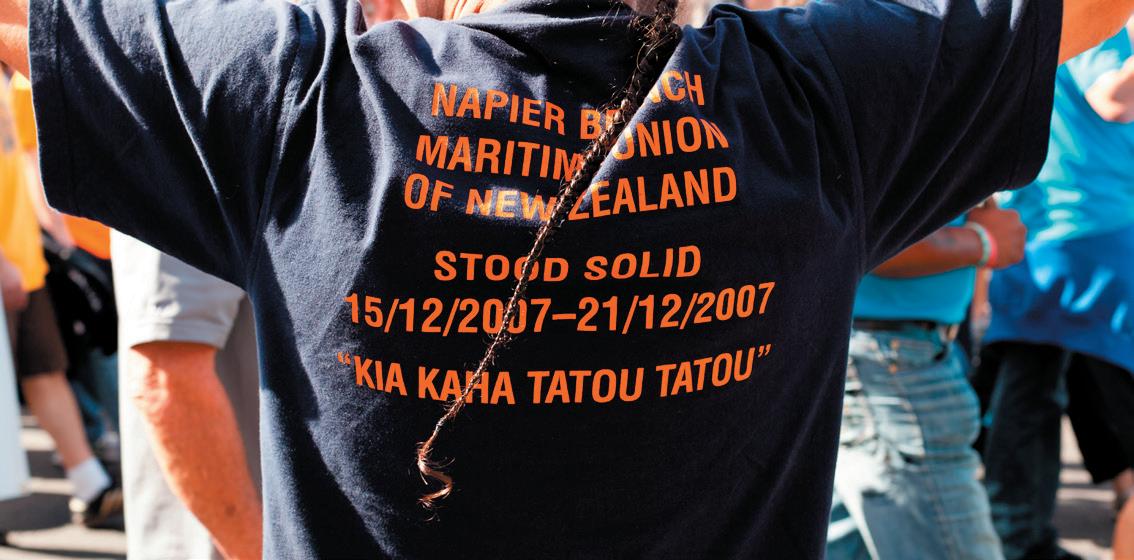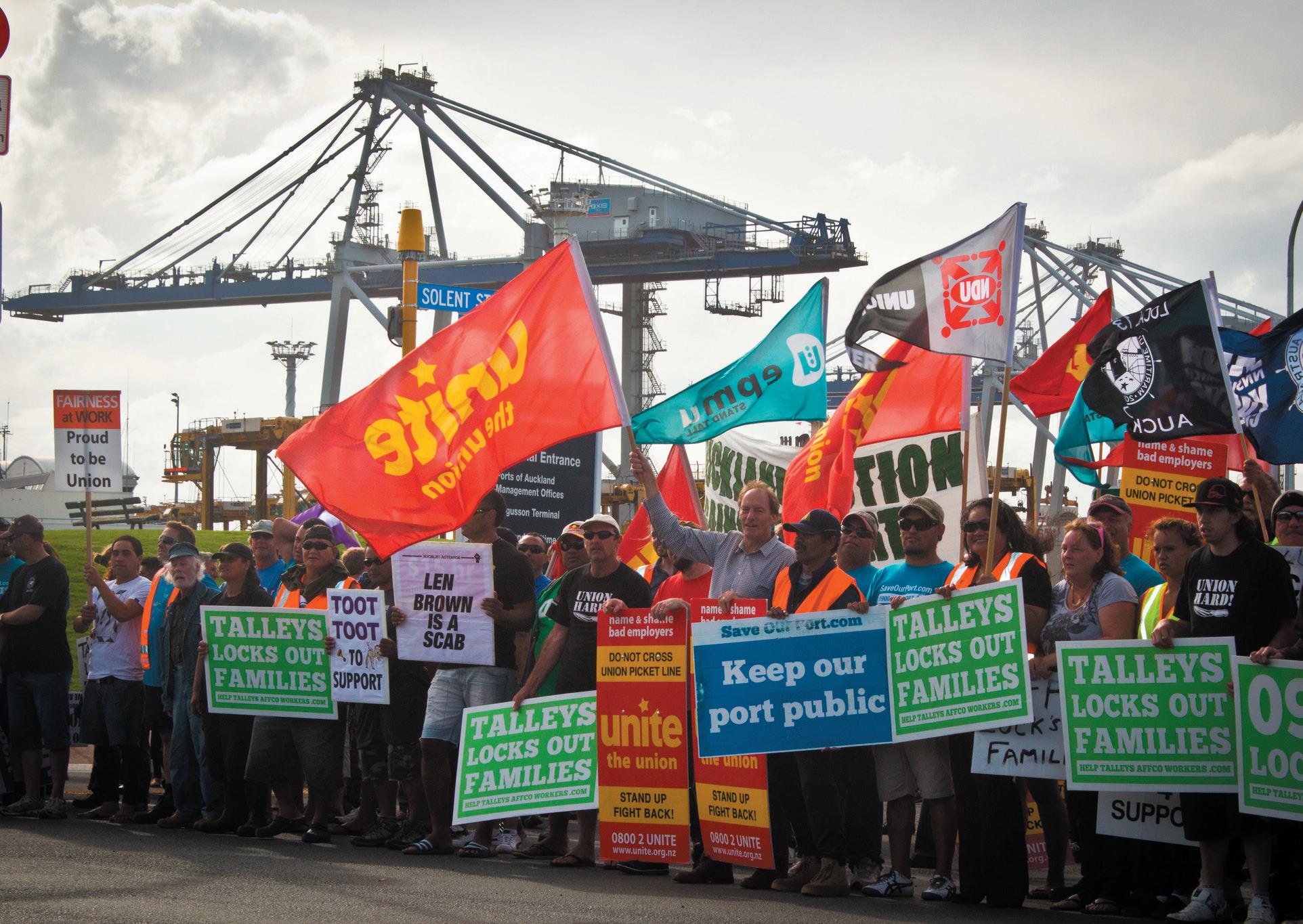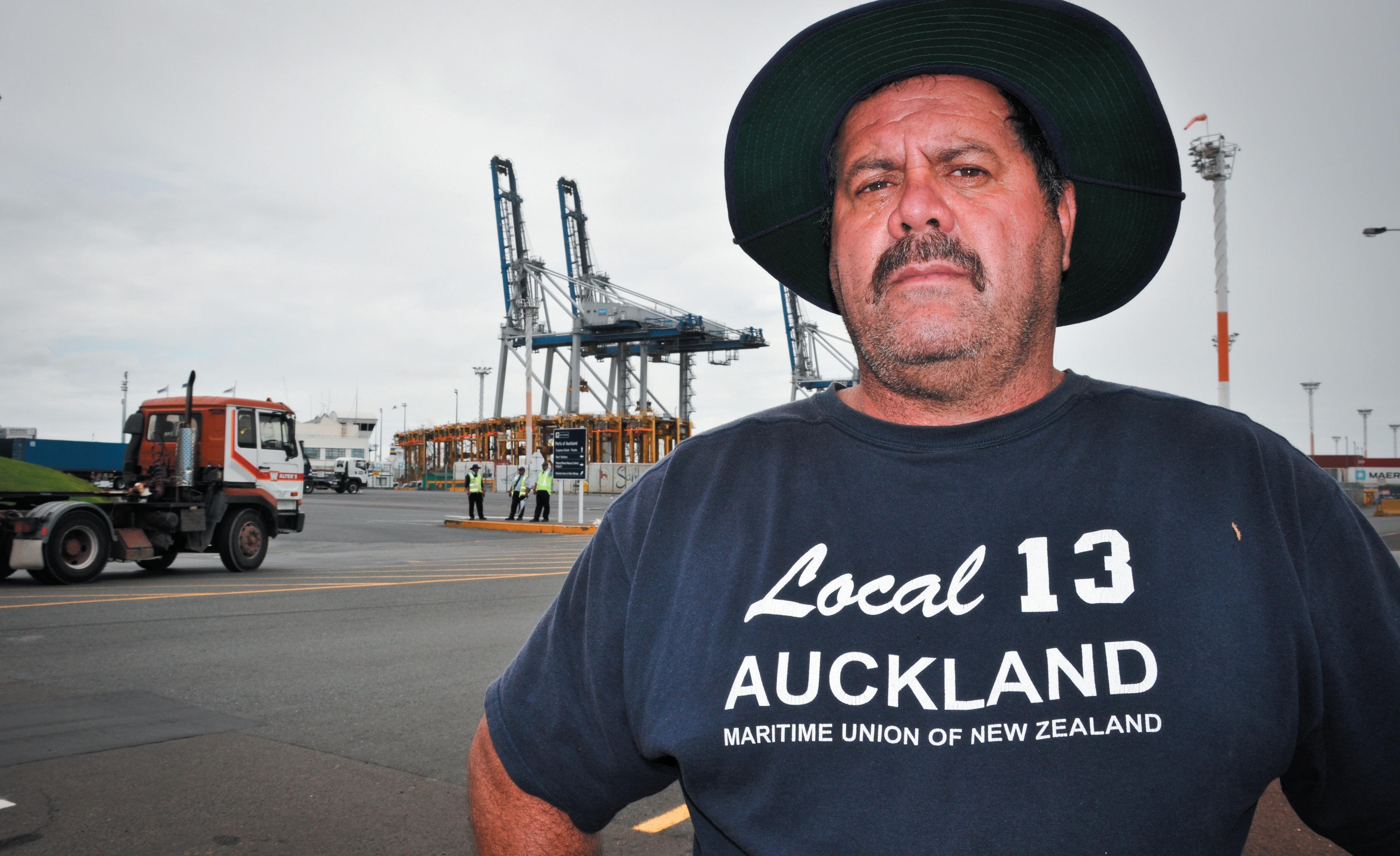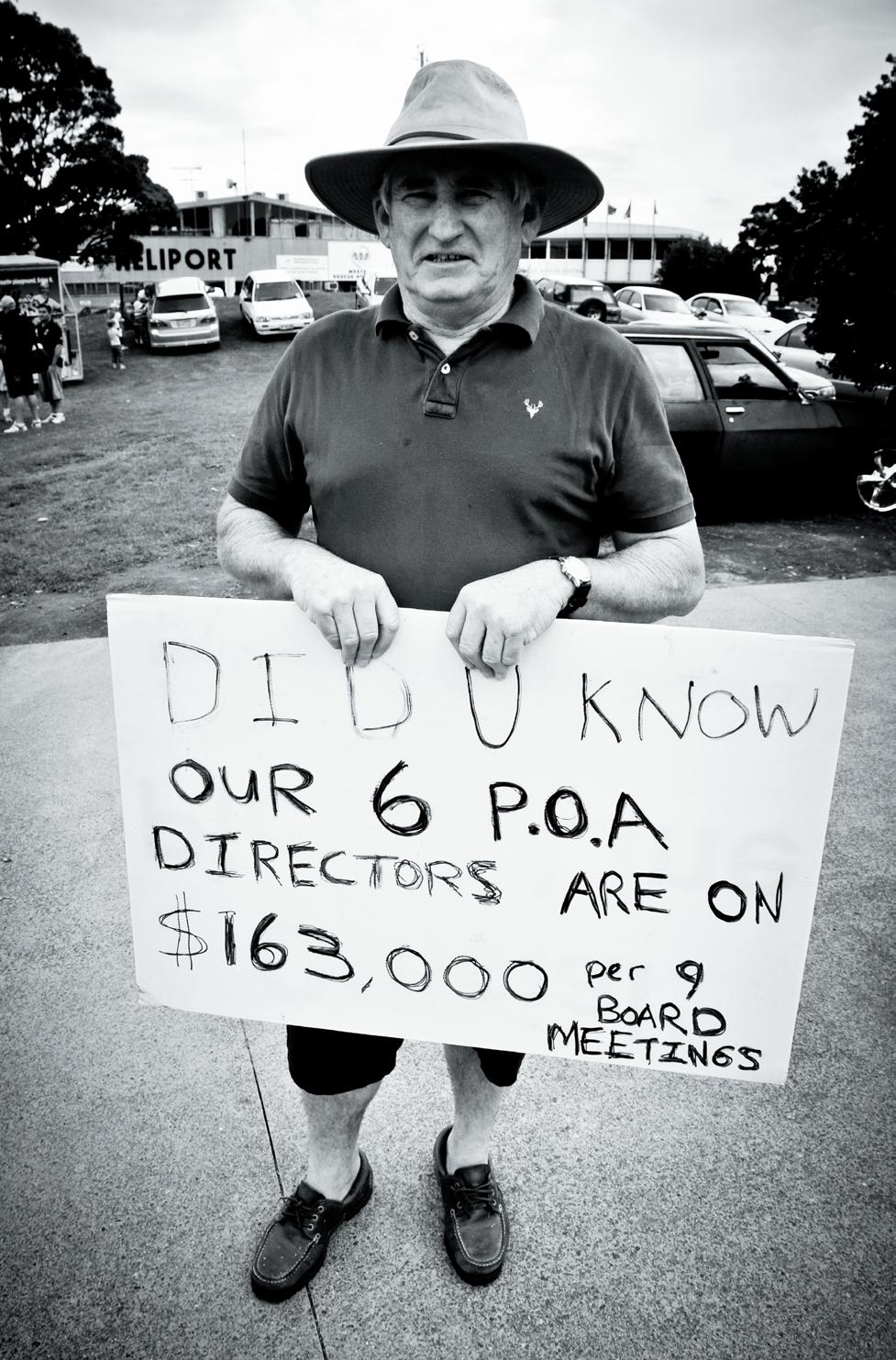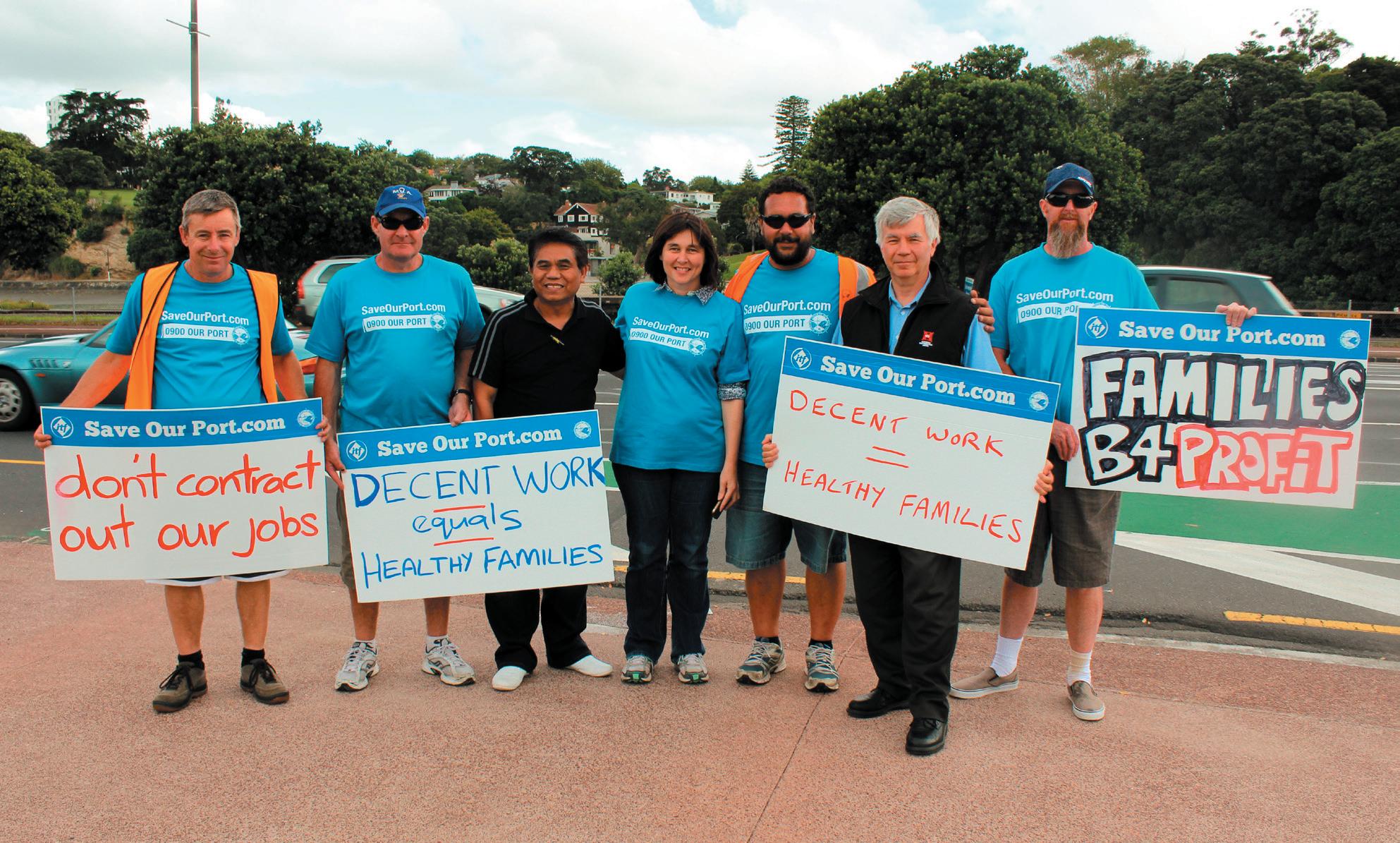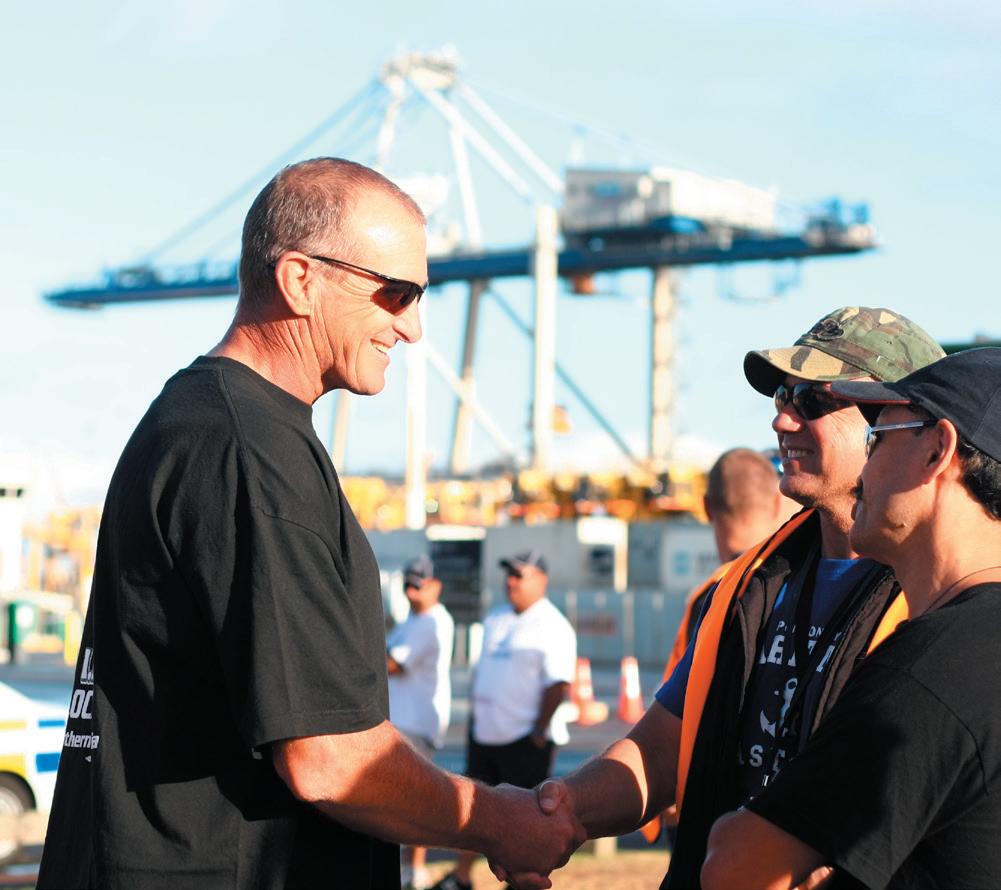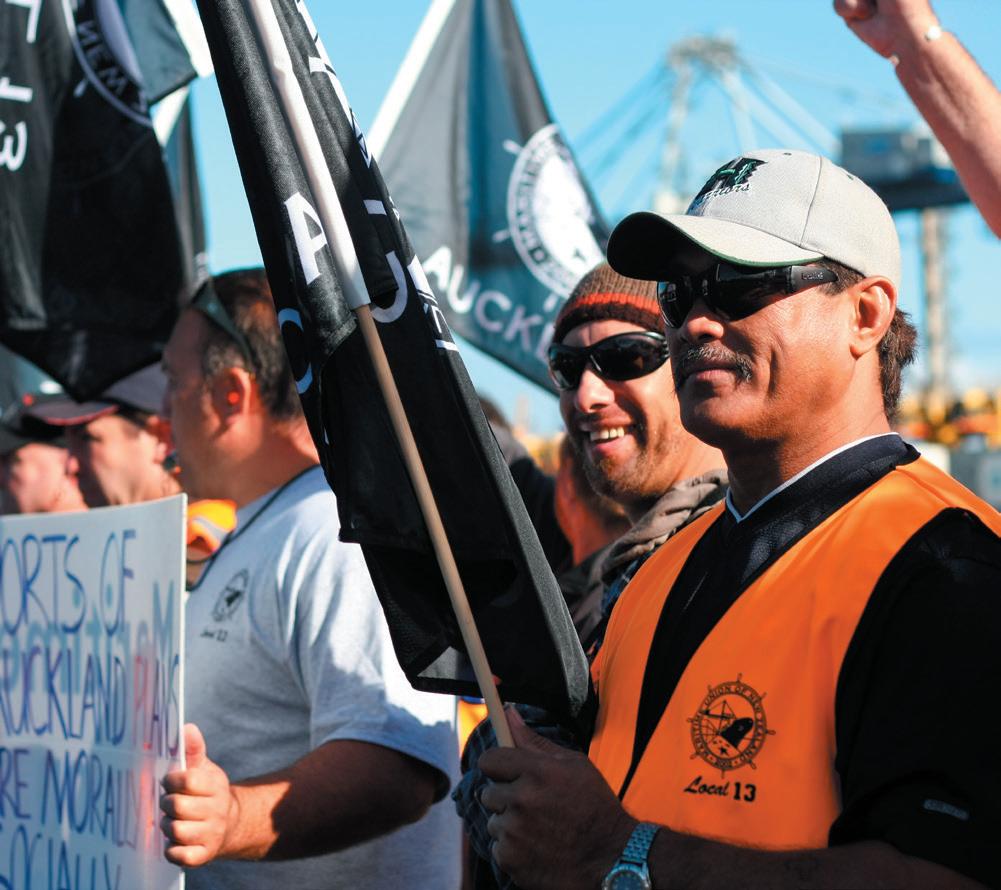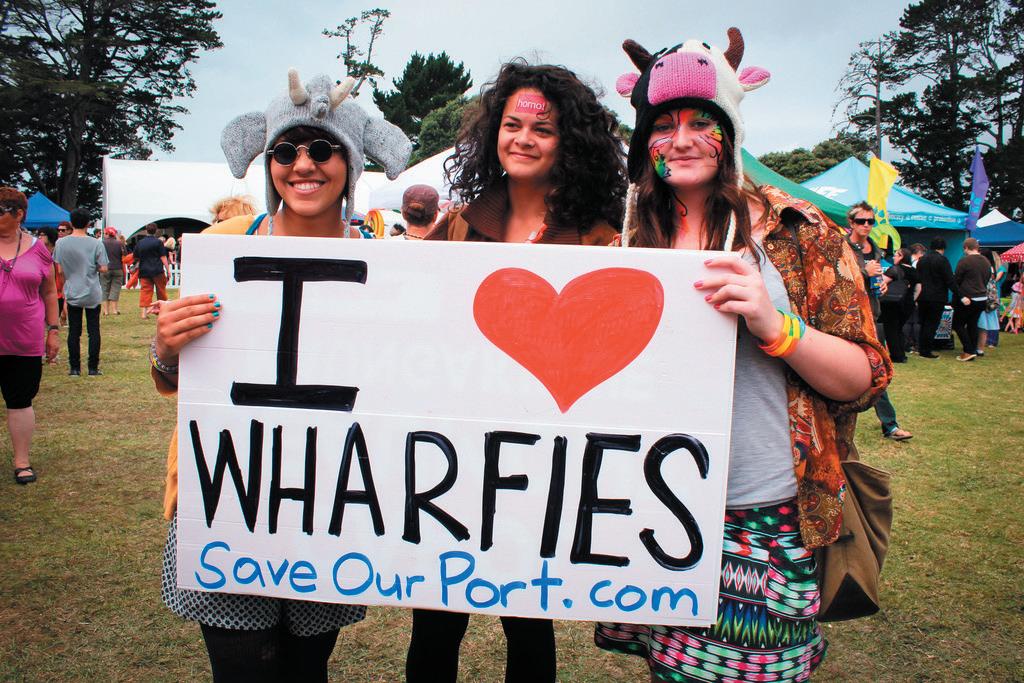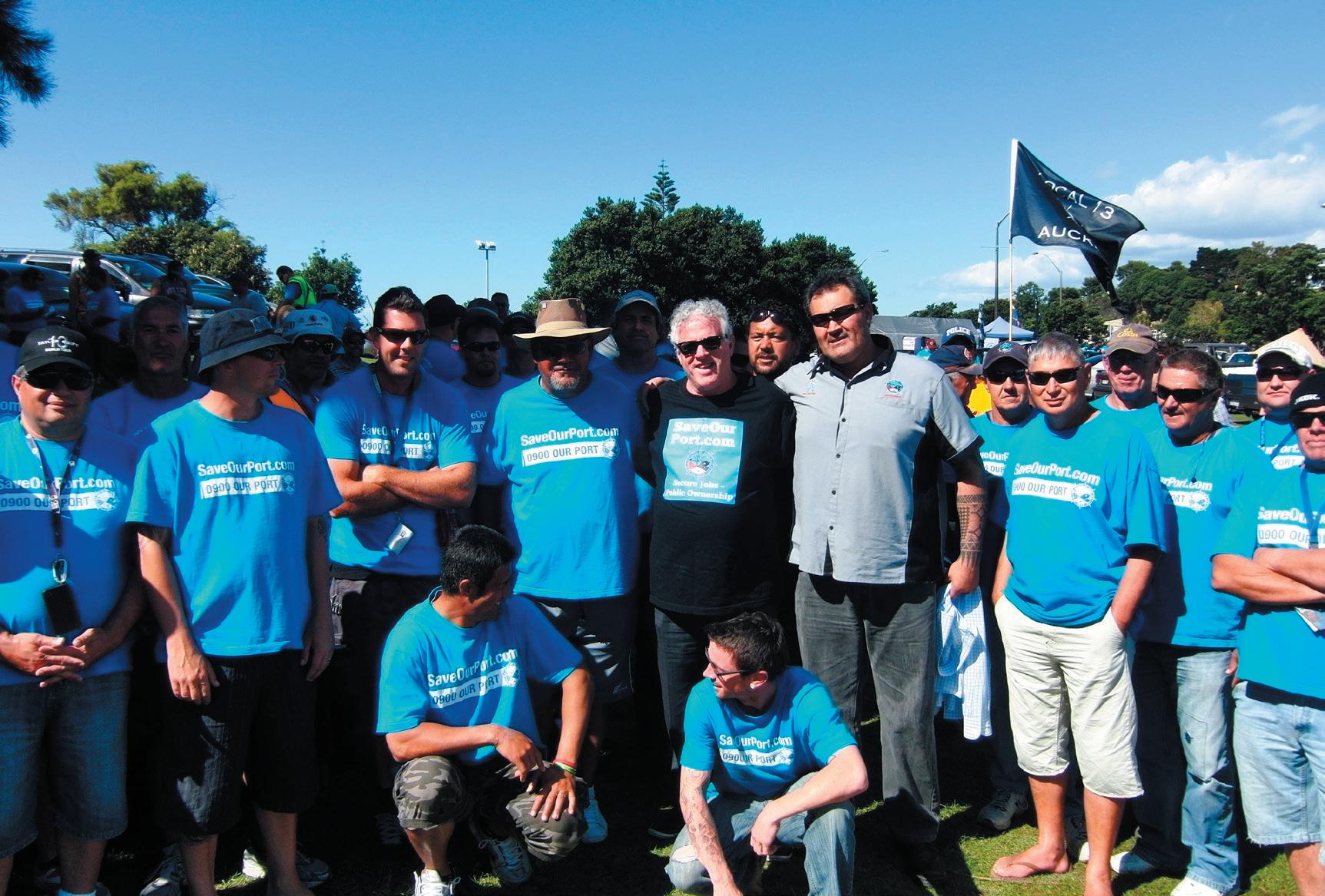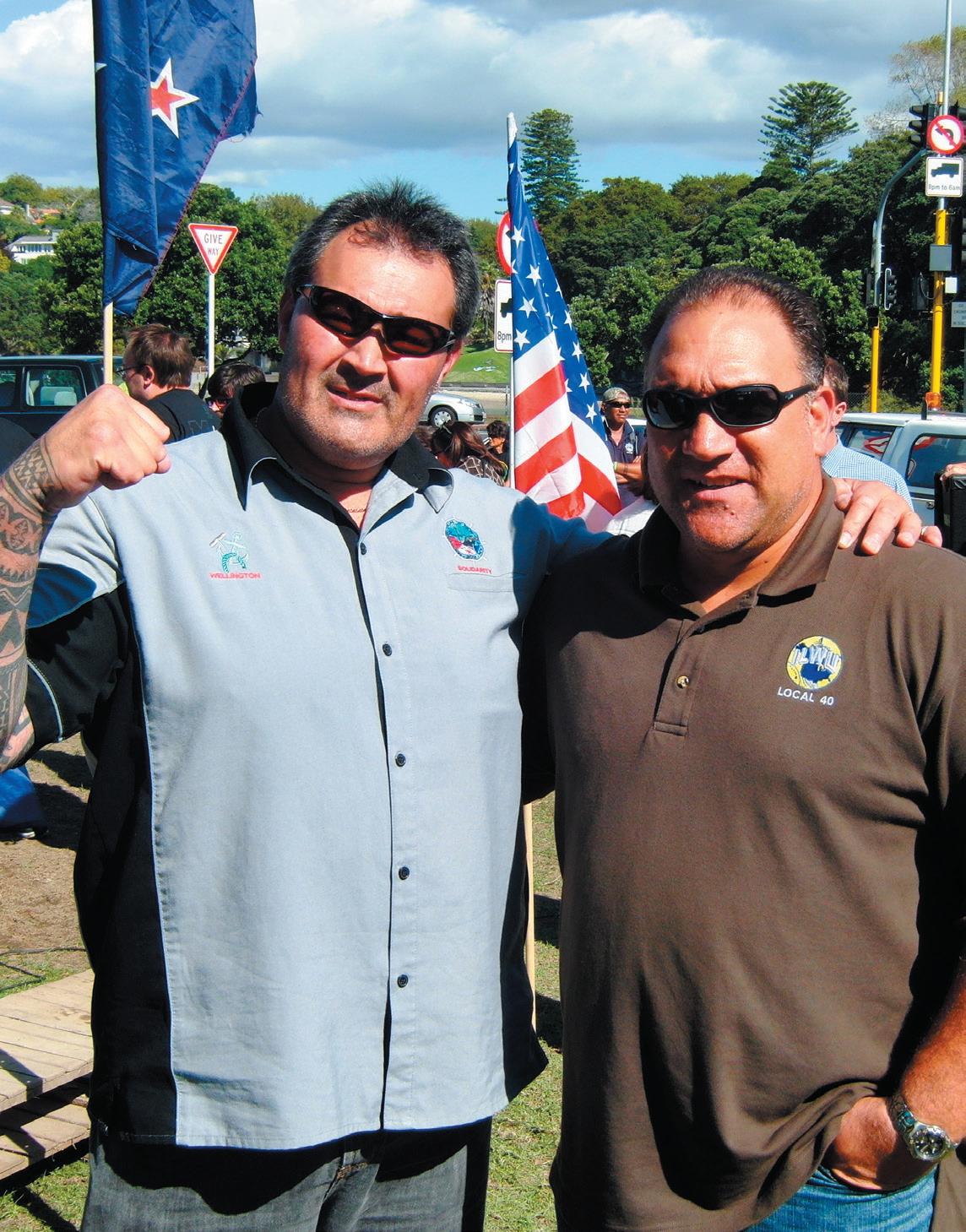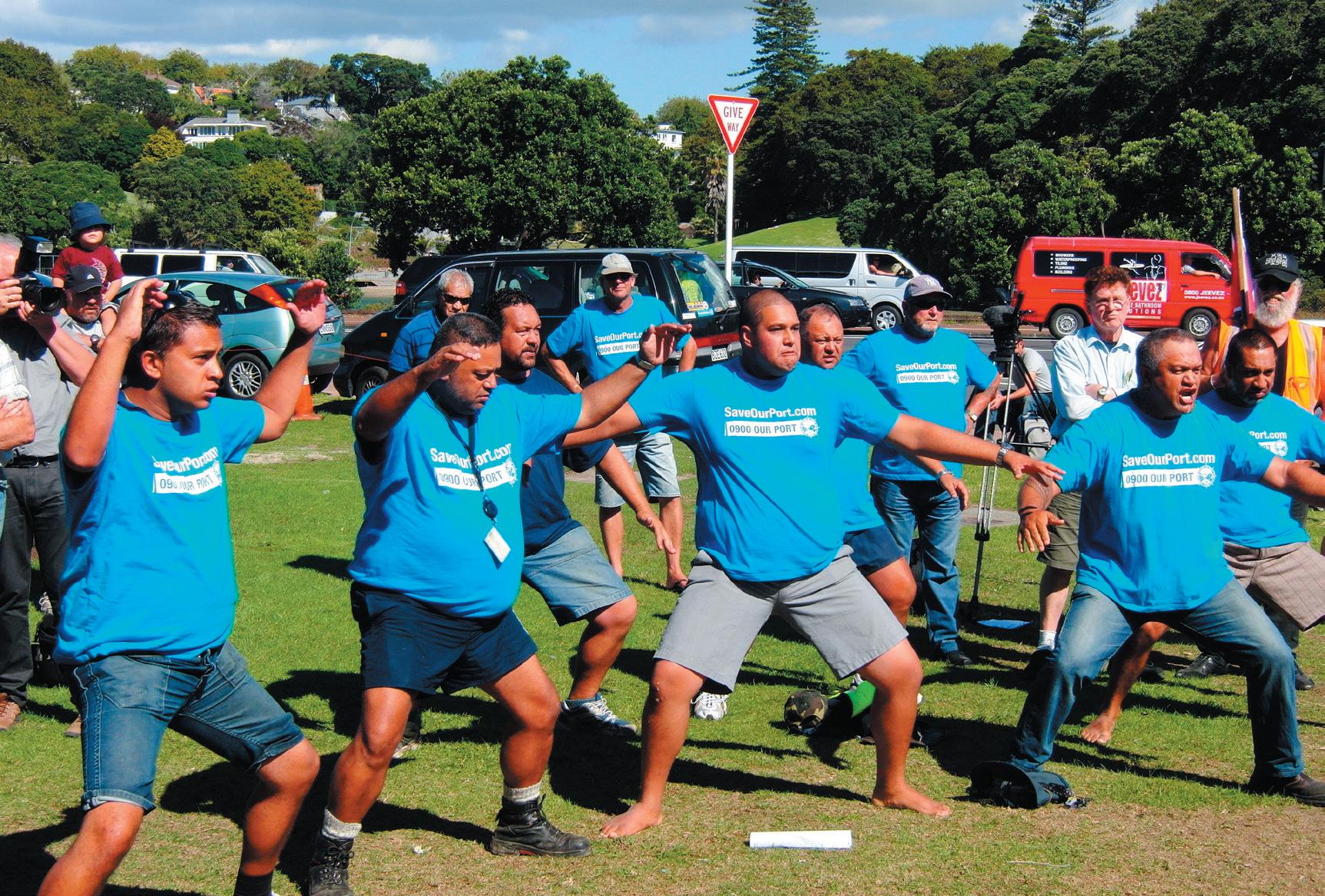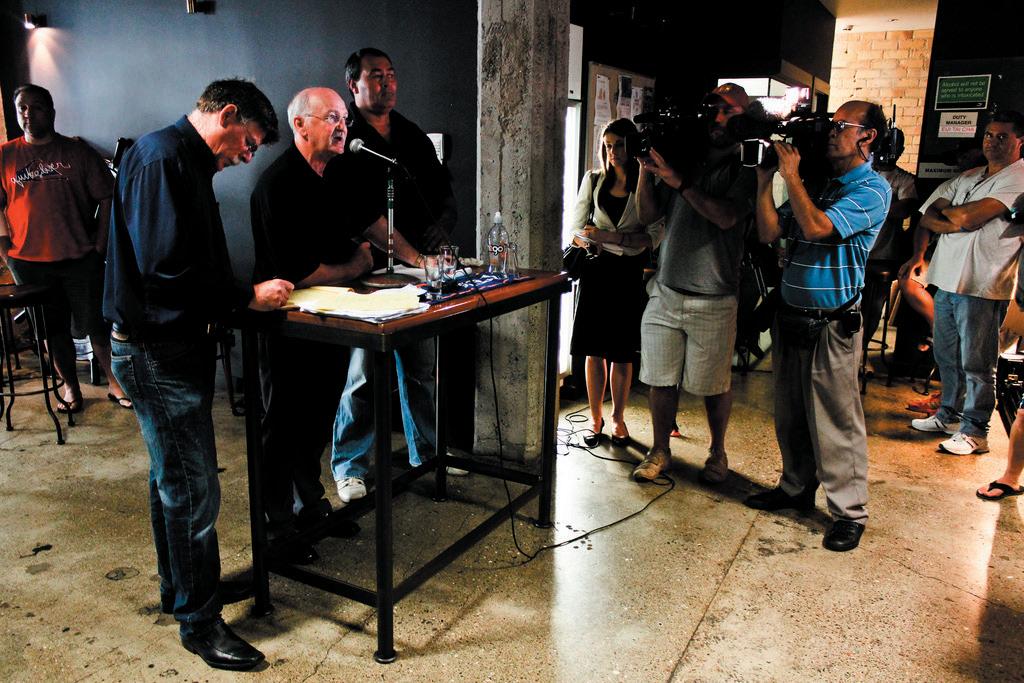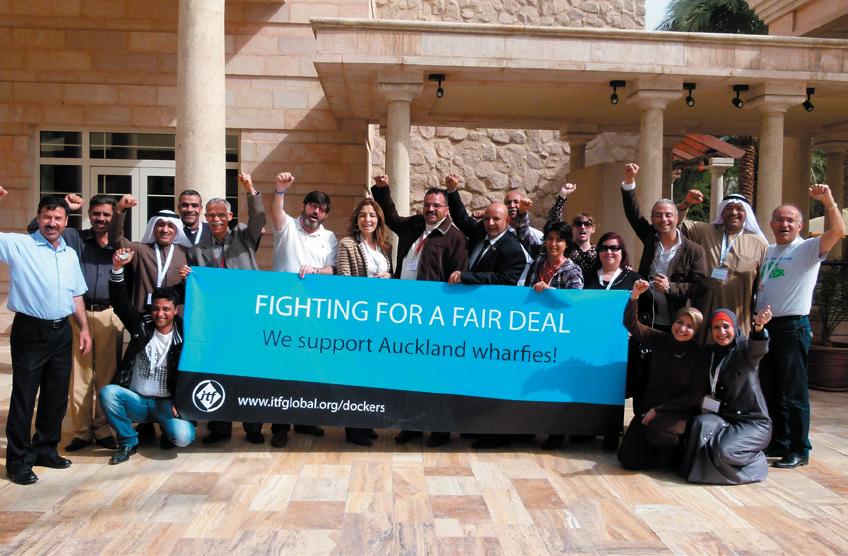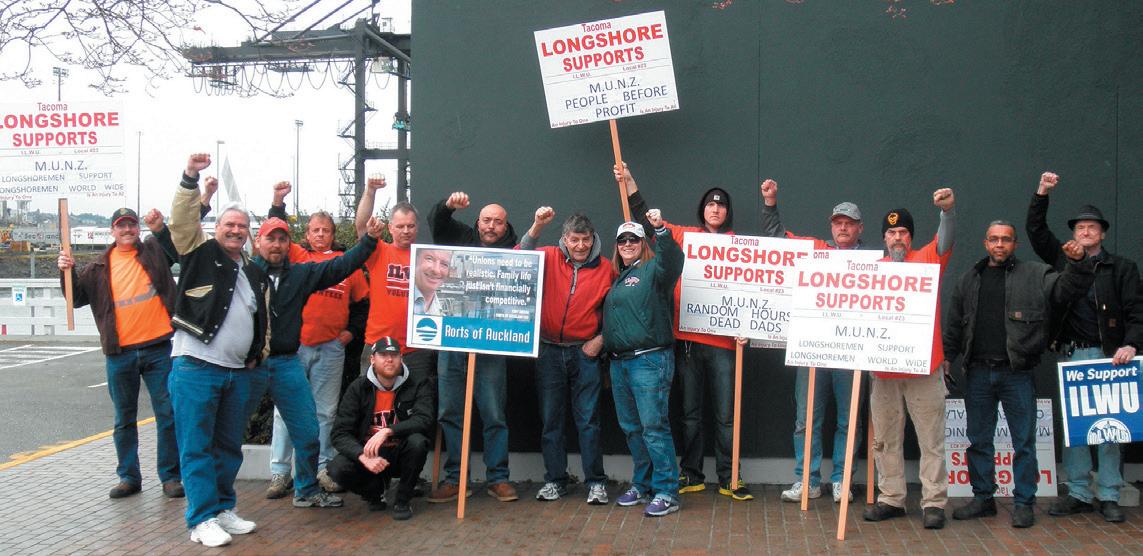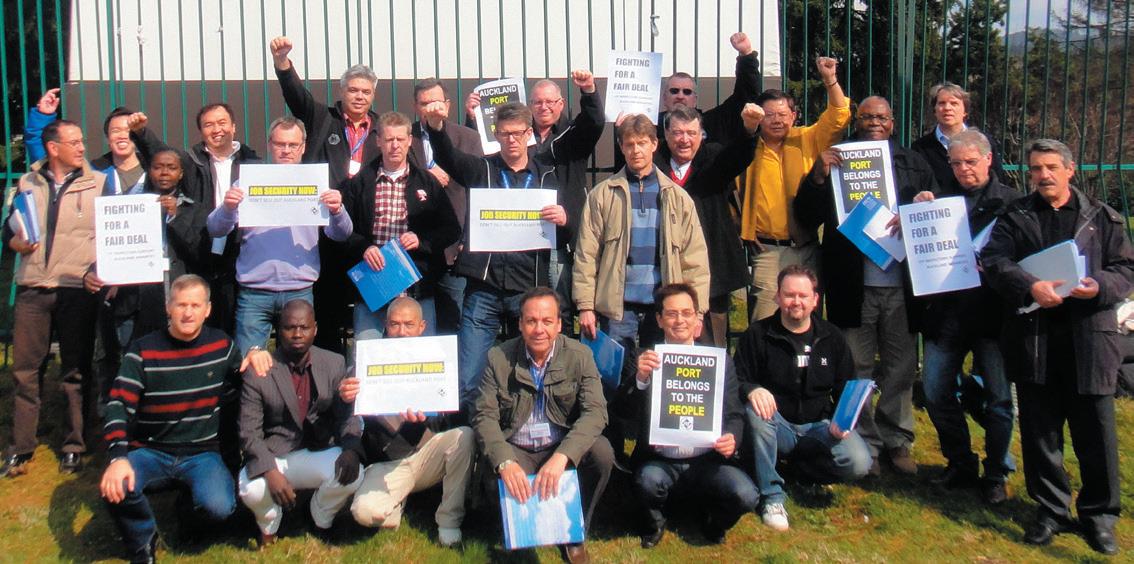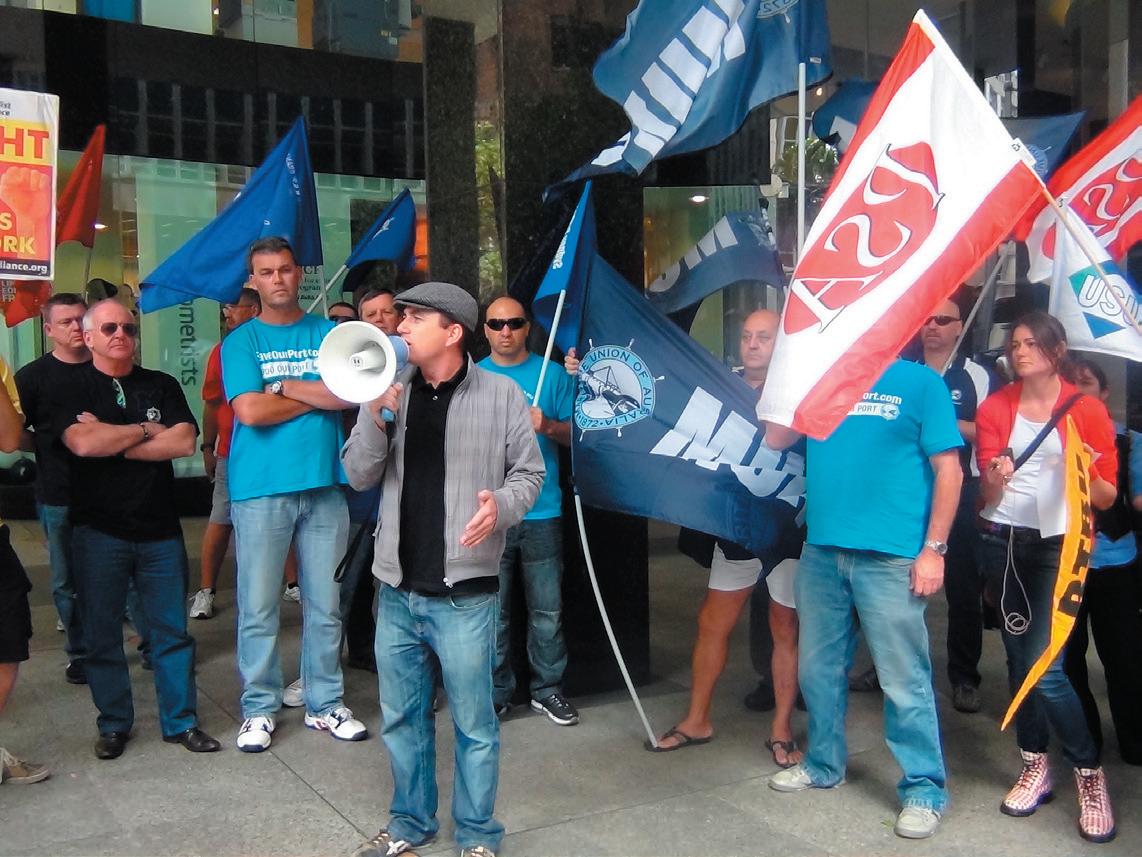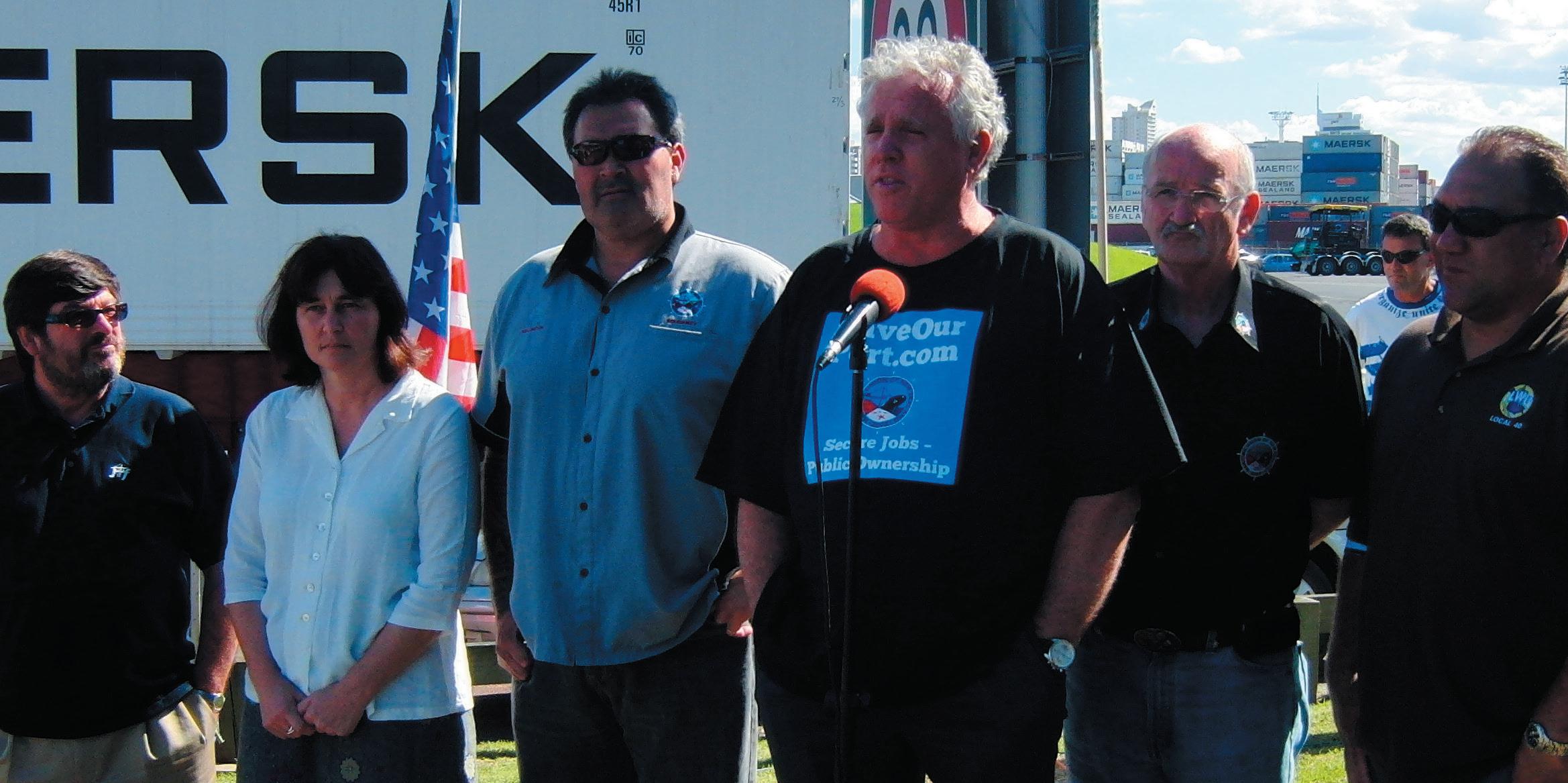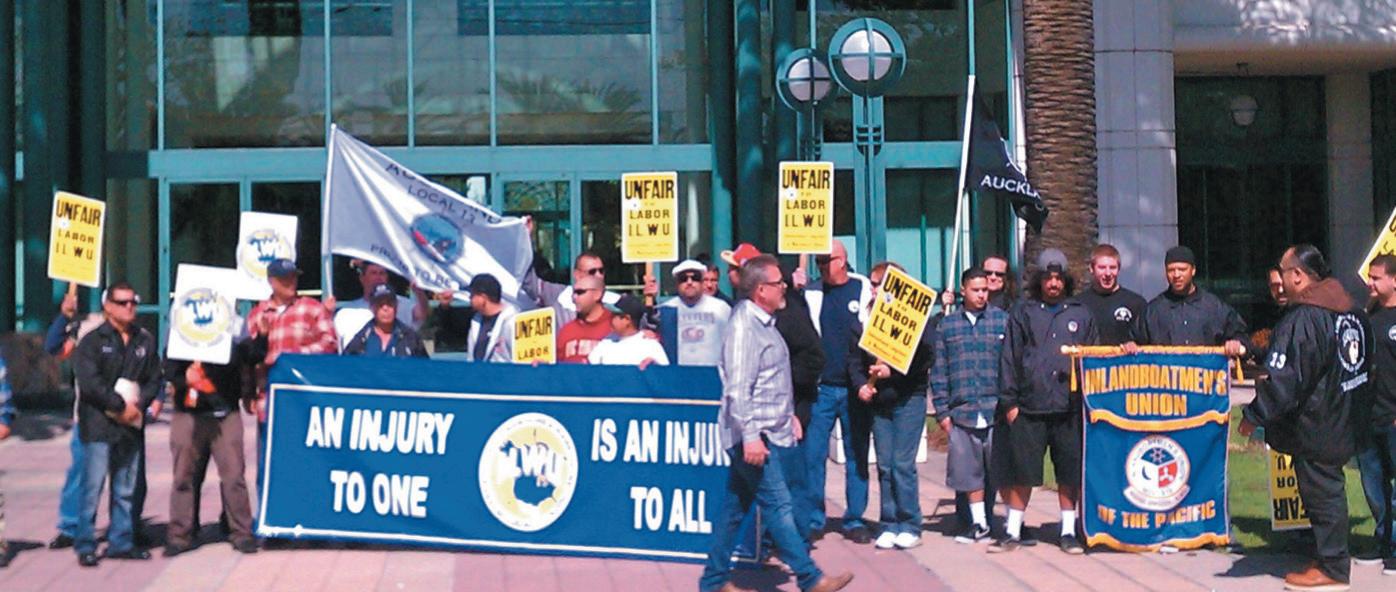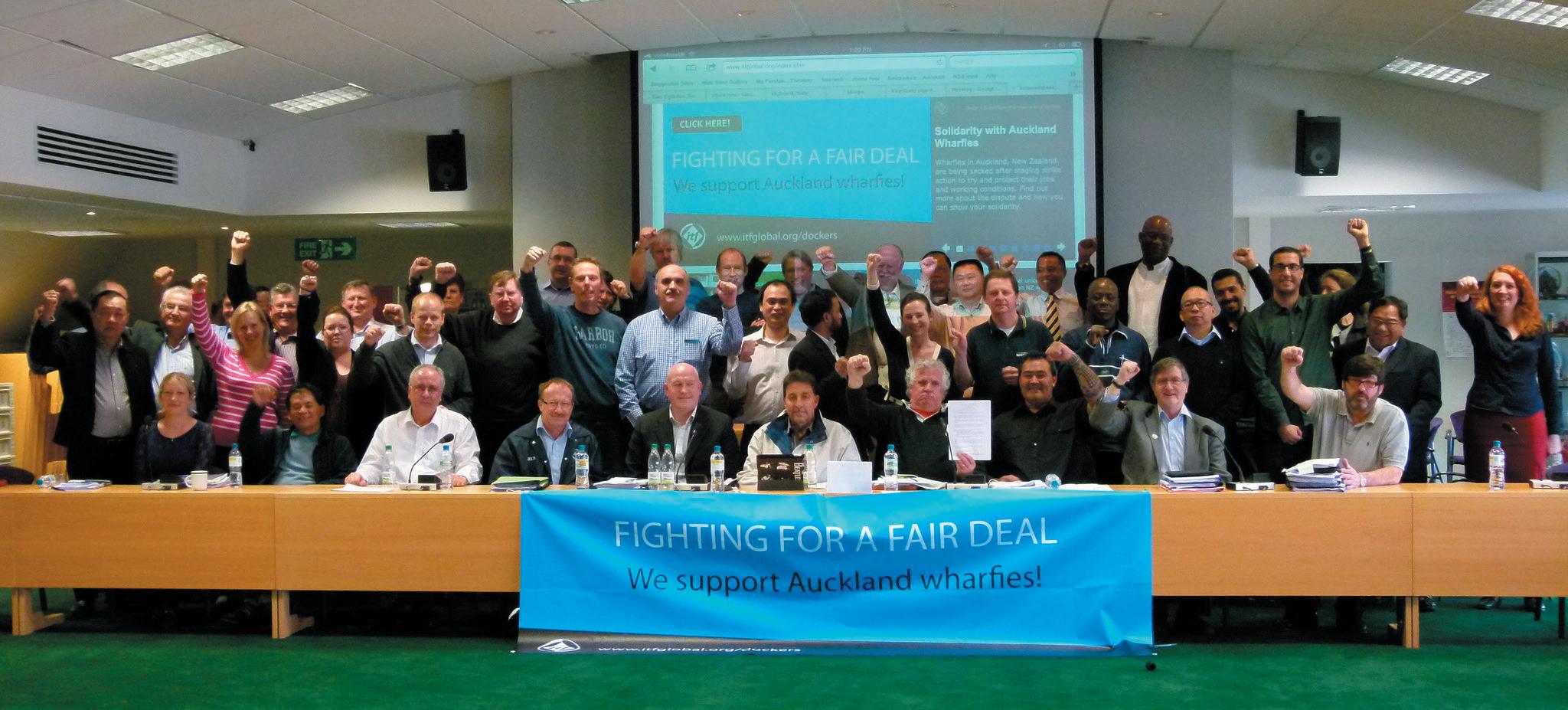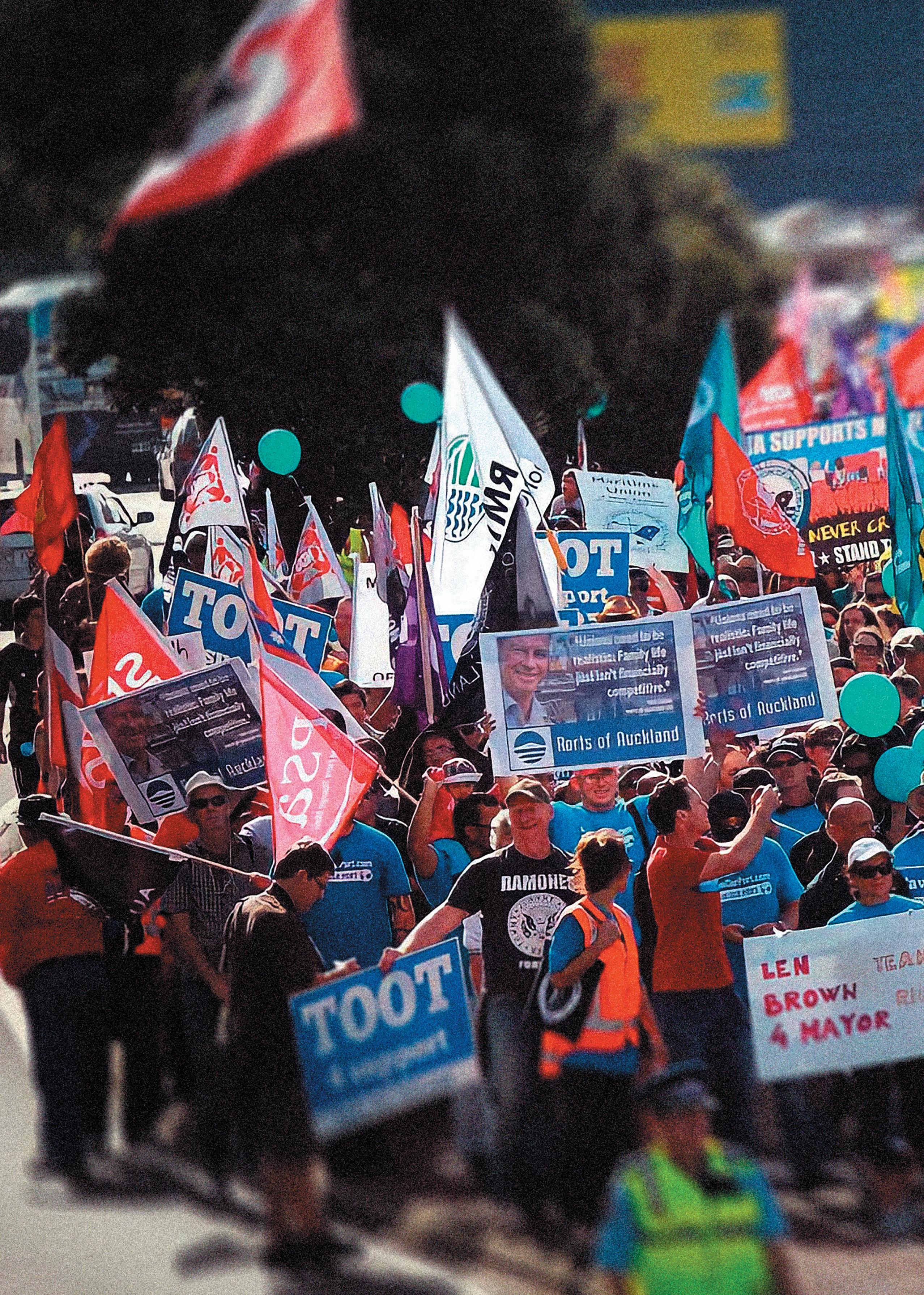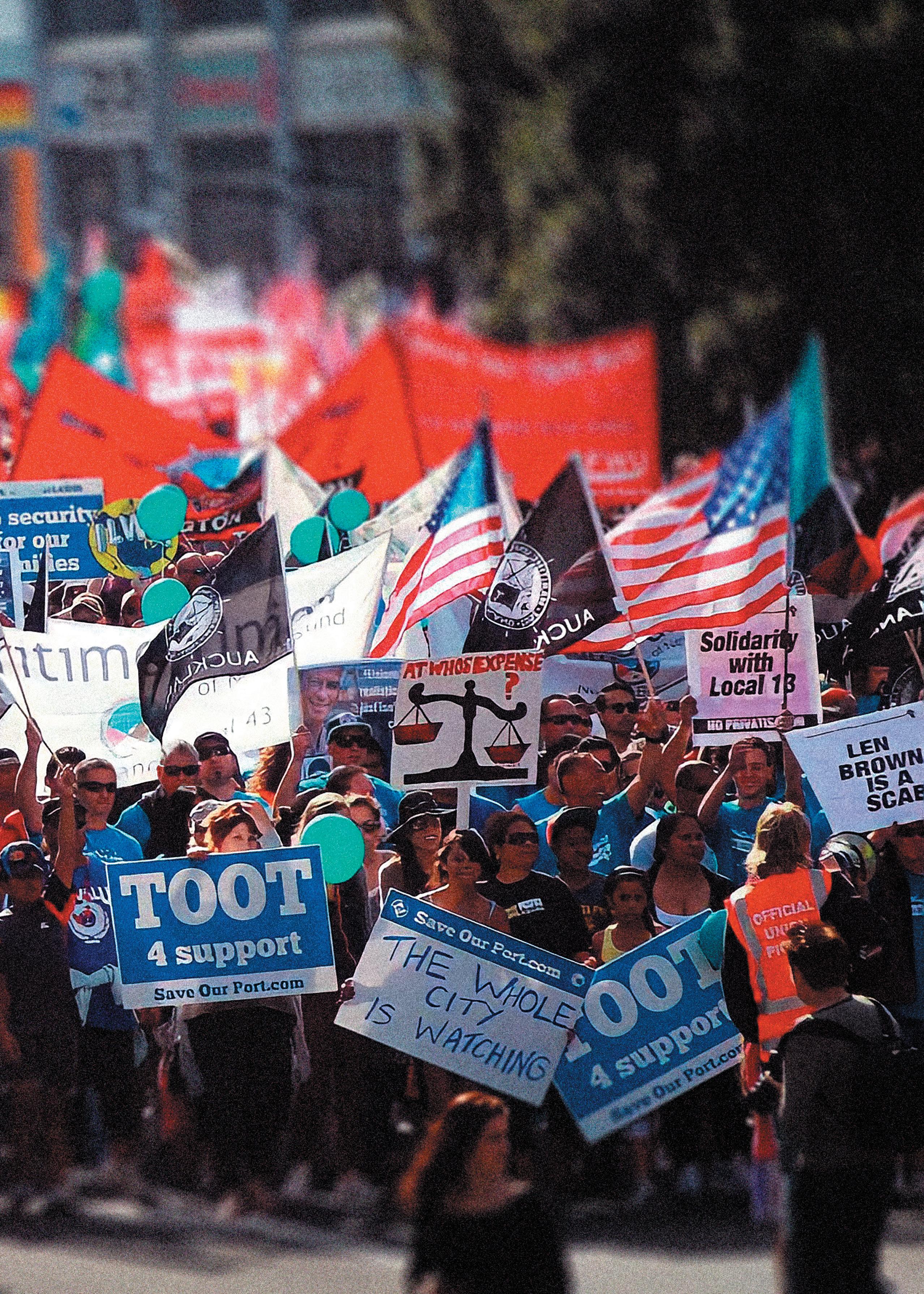
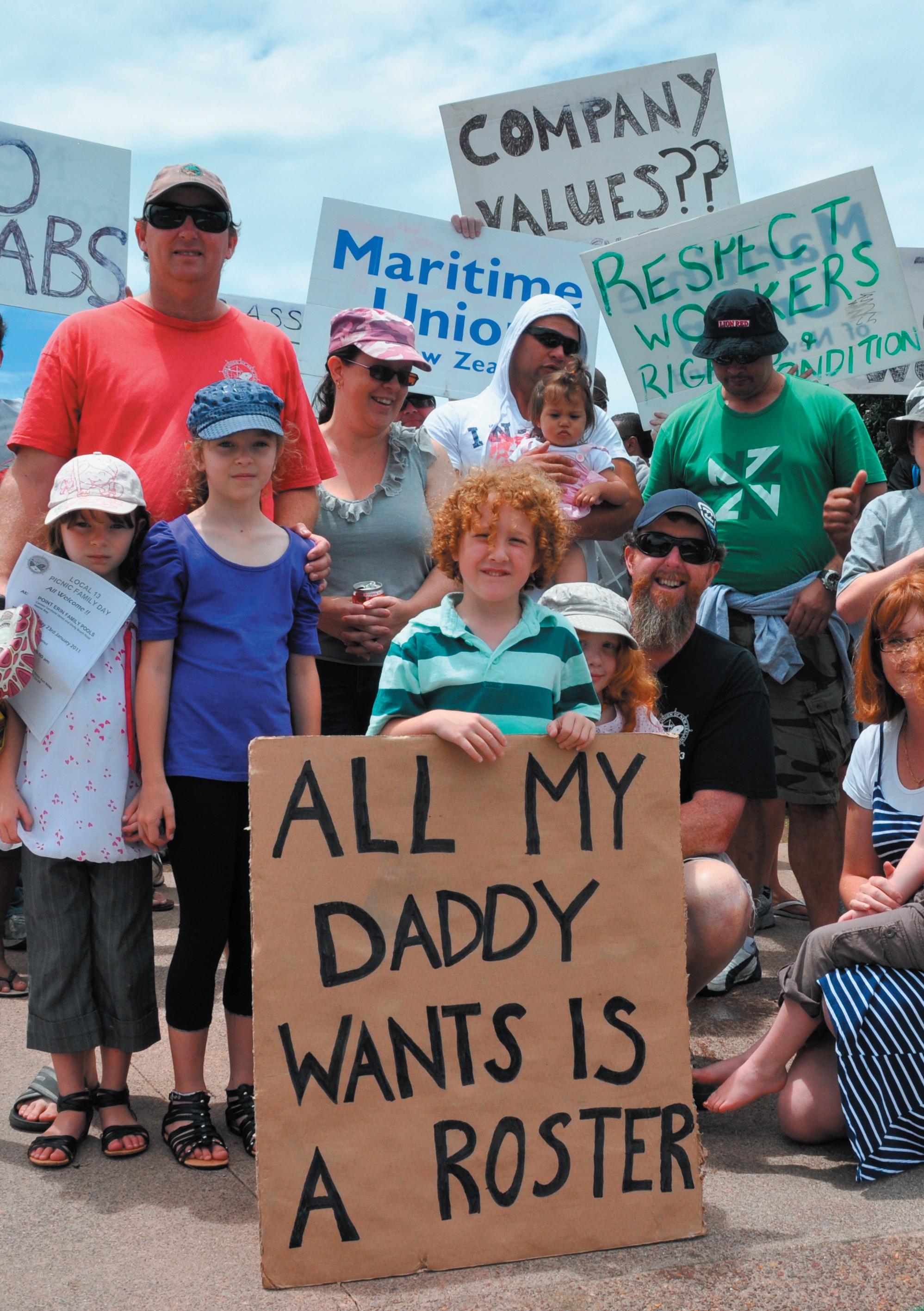 AUTHORIZED BY CRAIG HARRISON, 220 WILLIS STREET, WELLINGTON
CRAIG HARRISON NATIONAL SECRETARY
AUTHORIZED BY CRAIG HARRISON, 220 WILLIS STREET, WELLINGTON
CRAIG HARRISON NATIONAL SECRETARY


 AUTHORIZED BY CRAIG HARRISON, 220 WILLIS STREET, WELLINGTON
CRAIG HARRISON NATIONAL SECRETARY
AUTHORIZED BY CRAIG HARRISON, 220 WILLIS STREET, WELLINGTON
CRAIG HARRISON NATIONAL SECRETARY
Ports of Auckland management announced on 7 March 2012 that they would make around 300 workers at the port redundant in order to contract out and casualize their jobs.
This move followed months of negoti ations, a lock out and strike actions as the Maritime Union mobilized to defend jobs and conditions. A co-ordinated campaign to undermine organized labour was underway, linking Government, port managers and bottom feeding right wing spin doctors.
The following Saturday 10 March 2012, Maritime Union members at Ports of Auckland and thousands of their supporters marched on the Auckland waterfront to the gates of the Ports.
However, management had over-reached as the Employment Court found that their attempt to sack their way to victory rather than negotiate was unlawful.
Only a few weeks later, on Thursday 5 April 2012, Maritime Union of New Zealand Local 13 members ‘took back the port’ and walked in the gates of Ports of Auckland to resume their jobs.
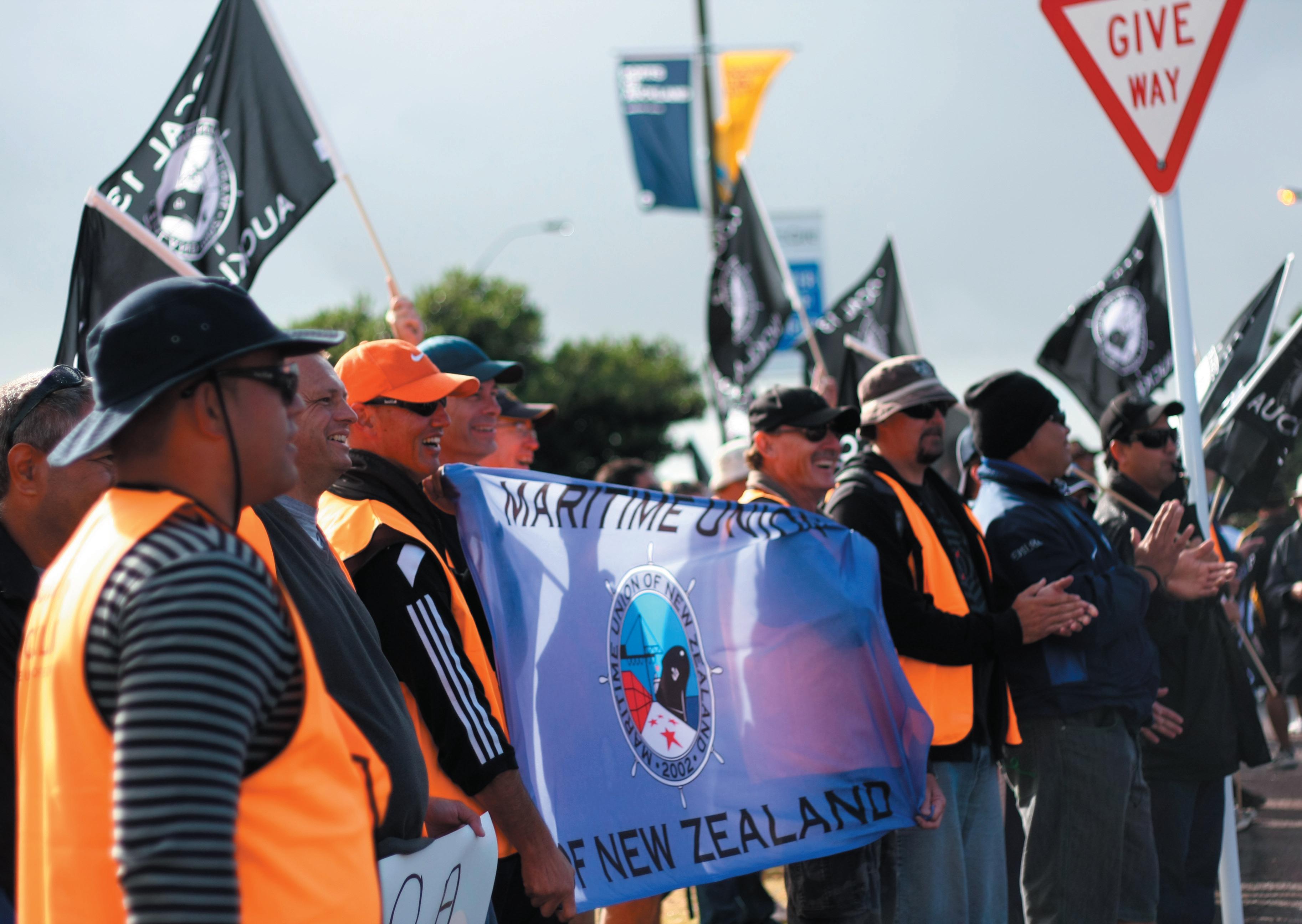
The contracting out agenda had ground to a halt. A major part of the employer’s agenda lay in ruins.
The battle may have been over but the war was not. The following decade would be a tough grind of attrition as port manage ment engaged in ongoing attempts to undermine safe working practices through speed ups and so-called “productivity.”
There was the promotion of an in-house association to split the workforce. MUNZ members were disadvan taged and treated unfairly.
There were several deaths at the Ports, including two workers and one member of the public. A massive auto mation project was begun in 2016, that rapidly ran into ongoing technical problems and cost overruns.
Conflict started to grow between senior manage ment and the Board, and their owners Auckland City, who repeat edly failed to rein in the empire building tendencies. There were also major debates about the future of the Ports as the level of freight increases in the northern North Island.
However one of the side effects of the COVID pandemic that arrived in 2020 was to expose the weaknesses of manage ment strategy at POAL.
As congestion at the Ports increased, poor decision making led to worse outcomes. The company laid off valuable staff in expectation of a downturn in trade, but as we know the opposite happened and the Ports found itself severely understaffed. Staff shortages contributed to the freight backlog and created huge problems for local industry.
2021 was a year of massive change at POAL.
Following the release of a damning report into health and safety at the port, in March 2021, workers at the Ports passed a vote of no confidence in the CEO and Board.
In May 2021, CEO Tony Gibson resigned. Mr Gibson is now awaiting trial for charges brought by Maritime New Zealand under health and safety laws. So ended a very unhappy time at Ports of Auckland.


In the last 18 months there have been huge changes.
A new CEO has been appointed and has committed to working with the Union. There has been a clean out of the Board with new board members having a better understanding of the port industry. Health and safety has been given clear priority. The Government has pushed forward a number of measures to improve health and safety practices at Ports. The big news for 2022 was the announce ment of the cancellation of the auto mation project at Ports of Auckland.
This was the right decision but it is now important a full review of the multi-mil lion debacle uncovers how a high risk plan was allowed to proceed and continue despite numerous warning signs.
Ports of Auckland is now recovering and employing new staff to cater for the ongoing growth in trade. We can add the good news that an unprecedented turn around in New Zealand coastal shipping has come about, driven by good Government policy and leadership from the Minister of Transport Michael Wood. More New Zealand crews will now be moving some of this new cargo on the New Zealand coast.
Most telling, MUNZ membership numbers have returned to a density and level which shows Ports of Auckland is now a Union port – a MUNZ port. The anti-union agenda of the 2010–2021 period has now ended. It was an extremely costly exercise. The cost was both finan cial and human. Many good people left the Ports due to the negative atmosphere
over this time. Many who remained faced ongoing stress and aggressive manage ment tactics.
Thanks to the support of families and friends, the people of Auckland and local representatives, and workers and their unions throughout New Zealand, secure jobs and public ownership were preserved at the Ports of Auckland. We remem ber the key role played by the then NZ Council of Trade Unions President Helen Kelly.
A special mention must be made of the
international support co-ordinated by the ITF. The presence and support of the global family of dockworkers and trans port workers was a massive boost to our campaign. The list is long but includes the support of the MUA, ETU, ILWU, and affiliates throughout the world. Thank you for your support and solidar ity. We couldn’t have done it without you. Last of all, thanks to the officials and rank and file members at Ports of Auckland who stood strong under difficult circum stances. In the end, our cause prevailed.
Thousands of Aucklanders marched to the gates of the Ports of Auckland on the afternoon of Saturday 10 March 2012, as the working class gave a defiant answer to port management’s contracting out and casualization plans.
“Whose port? Our port!” was a chant that echoed loudly across the red fence surrounding the virtually silent port.
The rally at Britomart and march along the waterfront to Teal Park was estimated to number 5000 people by TVNZ journalist Steven Smith who described a “sea of supporters for the watersiders . . . thousands, firefighters, meat workers, rest home nurses and politicians.”
The 10 March rally was called by the Save Our Port campaign, organized by the Maritime Union of New Zealand and the New Zealand Council of Trade Unions, in support of secure jobs and public ownership of the Port.
The mood of the rally was fired up by manage ment confirming earlier in the week they were proceeding with plans to make the stevedor ing workforce at the port redundant, and replace it with contracted out labour.
Flags and banners showed support from New Zealand unions for Ports of Auckland work ers, with a visible presence of firefighters, meat work ers and rest home work ers, who are all engaged in industrial disputes of their own at the current time.
Maritime Union branches from near and far were repre sented, including the northernmost branch Whangarei and the southernmost branch Bluff.
CTU President Helen Kelly said New Zealanders were increasingly concerned about the impact of casualisation on their families.
“We need jobs that are secure and safe, and that’s what
the Ports of Auckland dispute is about - a group of work ers who want the ability to be able to say when they’ll be free to spend time with their family, without the worry of being called in to work.”
Labour Party leader David Shearer spoke at the rally and told media the large turnout showed members of the public were behind the port workers and that unions across New Zealand were standing together on the issue.
“It just shows that I think the depth of feeling among people is that these workers have effectively been laid off. I mean these guys were laid off in the middle of mediation.”
MPs Darien Fenton, Denise Roche and Hone Harawira joined the rally, as did representatives of several socialist political parties and groups, students, churches, and other community organizations.
A large number of international delegates also attended the rally, including some from Australia and the United States. “These guys are not alone, this is a global issue,” Maritime Union Deputy National Secretary Mick Doleman told TV3 news at the rally.
He said management “better come to the party and negotiate and find a settlement ... otherwise the Ports of Auckland is going to continue to have grief and it’s going to get bigger and worse.”
“We’re obviously here to support the workers, the workers that have been sacked from the Port of Auckland – it’s a disgrace,” said Stuart Traill from the Australian Electrical Trade Union.
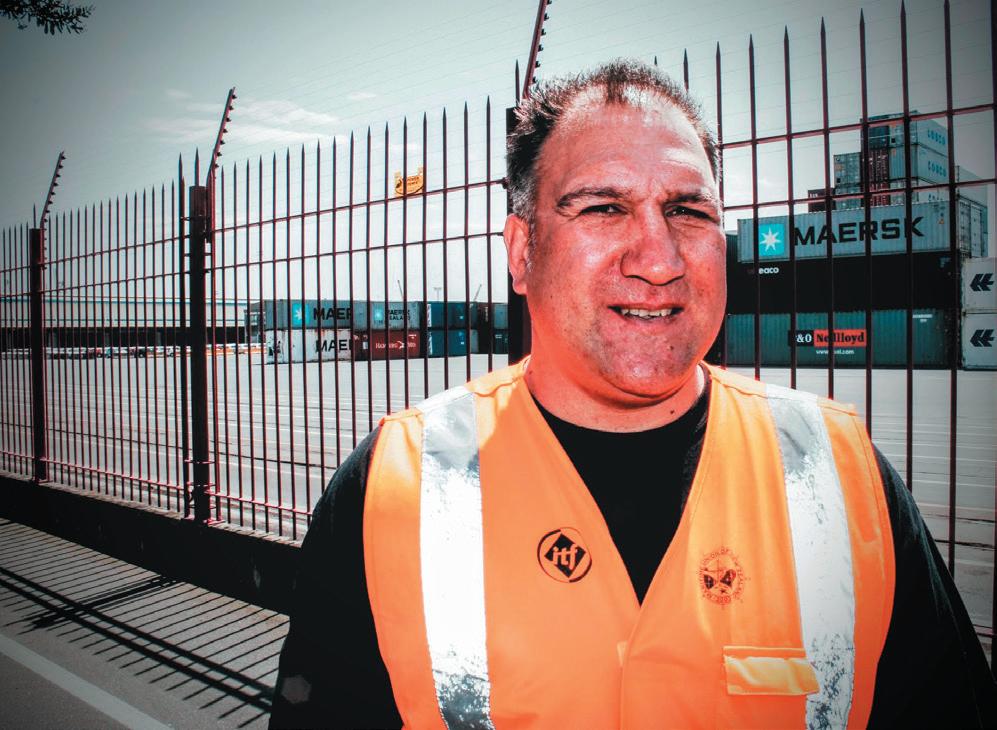
“It’s got nothing to do with productivity, it’s about busting unions. Unions are vital in the workplace and this is about respect and dignity, and about maintaining the Port of Auckland in public hands,” Traill said.
“We’re here to support the working class and the port workers here with the Maritime Union of New Zealand,”
International Vice President of North America’s International Longshore and Warehouse Union Ray Familathe told media.
“People are stepping up around the world. The inter national dock workers’ movement is well organized. There’s going to be support for the Maritime Union of New Zealand in ports all over the world, you can count on that.”
CARL FINDLAY NATIONAL PRESIDENT VICE PRESIDENT LOCALA Ports of Auckland manager once told me “hope is not a strategy.”
What he didn’t realize was “hope is a goal that you collec tively fight to get to.”
1 December 2021 marked a significant date in the 10-year struggle between the Maritime Union of New Zealand Auckland Branch Local 13 and Ports of Auckland management.
From 1 December for the first time since 2015, union stevedores at the terminal can only be mandated to work 48 hours in a calendar week with voluntary overtime, instead of being mandated to work 60 hours per week.
The struggle between Auckland Local 13 and Ports of Auckland manage ment has ultimately been about power and control. 10 years later it is the Maritime Union membership that has prevailed, and collectively we are taking back control of our working lives, but at great cost.
In early 2012 there was approximately 320 union stevedores at the termi nal. After being on strike or locked out for six weeks, thanks to a court order we got back in the gate. Ports of Auckland management then turned the heat up on the union members by several notches, talk about intimida tion and bullying. As always in any war there were plenty of selfish, greedy people who were willing, able and in fact enjoyed carrying out the orders of the new culture in management.
They starved Local 13 members of any overtime, limited the number of higher paid jobs a Local 13 member could pick up, upskilled anyone who was not a member of Local 13, but worst of all ignored any health and safety issues as whinging or politics. I recall one time complaining to the General Manager about Local 13 members treatment only to be told that “it was all perception!”
A lot of skilled workers and good union members decided they didn’t want to work for a port company that
was obviously heading in anti-family, morally corrupt direction. So, they made the courageous call to resign and find an employer outside the red fence that had a moral compass and would value their skills.

Others moved overseas seeking a better way of life for themselves and their families, or it was their time to end their working life and retire. Whatever the reason, skilled members left in large numbers and were replaced by a work force that were brainwashed at induction with propaganda by port management that “Ports of Auckland” was a fun place to work.
The new staff were told not to listen to those Local 13 union wharfies as they were “lazy”, and they did not have the same principles, values and culture as Ports of Auckland. Damn right Local 13 members didn’t have the same principles, values and culture of the Board, management or the CEO. The newbies were encouraged to embrace Ports of Auckland principles, values and new company culture that would have a devastating and last ing effect on staff, families and individuals and would leave us fighting for our jobs thanks to poor board and management decisions.
Ports of Auckland workplace deaths, serious injuries and systematic disregard for their employee’s health and safety have been well documented. Ports of Auckland have acknowledged this by pleading guilty and accept ing responsibility for two serious injuries and two deaths during court proceedings. Then there is the damage they have done to the shareholder who are the rate payers of Auckland with their failed policies and decisions.
The rank and file membership belief in our Union leadership and our legal team gave our officials the power to constantly lobby and push for meetings with Auckland city councillors and Government Ministers to getting our issues to the top table.
None of this would have been possible If it was not for the Local 13 Rank and File union membership which numbered approximately 80 stevedores and 30 engineer ing staff in 2019.
The Maritime Union and the wider union movement may have lost the Auckland terminal if not for the deci sion from our rank and file members to stay in the strug gle, survive and fight for their rights at the terminal with the upmost dignity, courage and self-determination.
This is no small achievement. It is a demonstration of unity and solidarity that deserves to be acknowledge and is a lesson to all of what can be achieved if you are prepared to stick together and fight back.
So, to the Local 13 terminal union members who stood together from 2012–2022 we thank and salute you. You’re an inspiration to the union movement and work ing-class people of New Zealand.
United We Stand.
in New Zealand to entice workers to the port.
They enticed Sandy McNabs to cross the picket line and rewarded them with Crane Operators positions, then paraded them on media outlets as being the saviours of the Waterfront who were willing to accept twelve hour shifts and live on the end of a telephone.
2022If the 1951 Waterfront Lockout is remem bered as the “Big Blue” then the Maritime Union of New Zealand, Local 13 and the Ports of Auckland Dispute can certainly be remembered as the “closest thing to the Big Blue”.
This was a well-resourced plan to attack organised labour on the Auckland Waterfront, with a right-wing agenda to take on the Maritime Union firstly in Auckland and then roll this attack out across all the Ports in New Zealand.
The primary assault came at the work place with a non-negotiable claim from the Company to introduce wholesale changes into the workplace that removed all of the protections the Union and its membership had fought for years.
Sitting behind this was a media campaign devised to depict MUNZ members as lazy overpaid thugs and gang members. Members personal details were leaked to the press and outrageous claims started to appear on blogs and other media outlets.
The changes that the Company hench men wanted simply could not be agreed by the workers, and what resulted was strike action and lockouts which accumulated to an indefinite lockout issued by the Port Company.
When it was clear that the threat of an indefinite Lockout would not win the day, the company then issued every MUNZ member with notice of redundancy. The company set up a contracting firm using two POAL managers as the owners of the contracting company, and this company would supply all the Lashers for the Port.
They advertised internationally for Container Crane Operators and other skilled positions, using employment companies
Welcome to the brave new Waterfront – flexibility without rights. If they could have, they would have had us carrying the containers off using hand barrows and shopping at the company store.
The then POAL CEO Tony Gibson vowed that none of the Maritime Union members would ever be back on the Waterfront, redundancy was the means, and the Auckland ratepayer would foot the bill.
So it is off to court we go, as well as picket lines. International support flowed in from across the world, notably MUA, ILWU, ETU, Steelworkers just to name a few of the many, and then you add the Kiwi ingredient.
Local unions from across New Zealand threw their support in behind the Wharfies. Jock Barnes “Never a White Flag” took on a new meaning as everyone hunkered down for the duration.

The assistance we received financially and morally peaked in one of the biggest marches seen in Auckland for a very long time. Quay street on the Waterfront was heads to tail with supporters, flags and banners filled the air and the message was loud and clear to Tony Gibson, his managers, the Board and the Mayor “hands off the Wharfies”.
To this day I remember with fond ness the banner one wag had made with a picture of Tony Gibson and the title “Rorts of Auckland”.
The debt the Union owes to fellow union ists in New Zealand and across the globe will never be forgotten. Some in the media called it the Maritime Union rent a mob and tried to downplay the protest.
Jumping ahead our legal team headed by Simon Mitchell, Peter Cranney and QC Colin Carruthers put together a left field legal challenge. After many Judicial Hearings
and a final court case this resulted in an injunction that ordered the Port Company to withdraw the redundancy notices, and let our members back in the gates to their right ful place of work.
It was a proud day when the first group of workers from Engineering entered the Port, but what followed was 10 years of discrim ination against union members – hours of work that belonged to the eighteenth century, open slather on poor work practices, health and safety was non-existent.
It was the start of ten years of MUNZ running legal challenges and submis sions against the unfettered bonus systems. Watching while the company yellow asso ciation was favoured, and Maritime Union members were constantly placed on disci plinary charges and sacked at the drop of a hat.
A culture of speed developed as work ers chased the top ten percent performance bonus, shortcuts became the norm and what was once a safe workplace morphed into the most dangerous Port to work in New Zealand.
The tragedy was that it took the death of two workers and numerous serious inju ries to bring the Ports of Auckland to accountability.
The Mayor of Auckland called for an inde pendent health and safety review (CHASNZ) of the port, and this report was damning. It uncovered systemic failures along with numerous other managerial failings.
Even after the release of the report the management clung on for dear life, again public pressure increased and finally CEO Gibson resigned in 2021. POAL was charged under the Health and Safety legislation by Maritime New Zealand and for the first time in New Zealand’s history, a CEO was also charged under Health and Safety legislation. It should be noted the cases are due to be heard in the court sometime in 2024.
Whilst all this was taking place, in 2015 the CEO announced that the company was embarking on an Automation project. The container terminal at Fergusson Wharf would become the first automated terminal in New Zealand – it would be the first of its type in the world where automated straddles would interface with manually driven strad dles. The claim was it “should be a doddle”. All of this would mean the loss of seventy
stevedoring jobs at stage one and who knows how many when stage two and three were rolled out. All of this investment in new and undeveloped technology at a small port in Auckland, New Zealand.
Members of the ITF automation commit tee laughed when they saw the size of Fergusson Terminal and the telling comment from one member was “Boy, they must hate you to go down this path.”
New robot houses were built at Engineering to house the 28 new autono mous straddles that would spring into oper ation in 2019.
2019 slipped by and cargo was still being moved by our members driving manual straddles. 2020 and 2021 failed to produce the ever-resplendent blue robot straddles and finally in 2022 after failures, poor productiv ity, and continuing safety issues new manage ment in the Port took the only option left and that was to can the whole automation project.
The previous management were success ful in taking a port that returned $60 – 80 million to Auckland ratepayers to a port to effectively nothing.
The relationship between the Union and POAL management is very different today. We have a new CEO and managers at Fergusson Terminal, a new board and new chairperson. An hours of work policy that is a vast improvement with Health and Safety a priority for everyone from the board down to the coal face.
In summary Fergusson Terminal is a very different workplace than it was during the ten years leading up to where we are now. The Maritime Union is back to membership density in the high nineties and we have one of the safest terminals in New Zealand.
The absolute tragedy of all this is that it took the deaths of two workers and the worst Health And Safety record of any port, again to quote the independent report the result of “systemic failures in Health and Safety.” You would wonder how this could happen in the 21st century.
The ten years between 2012 and 2022 will forever be recorded in history as disgraceful and depending on what comes out of the court case, potentially criminal.
Two workers will never see their families and friends again for no good reason.
“An Injury to One is an Injury to All”
Russell Mayn